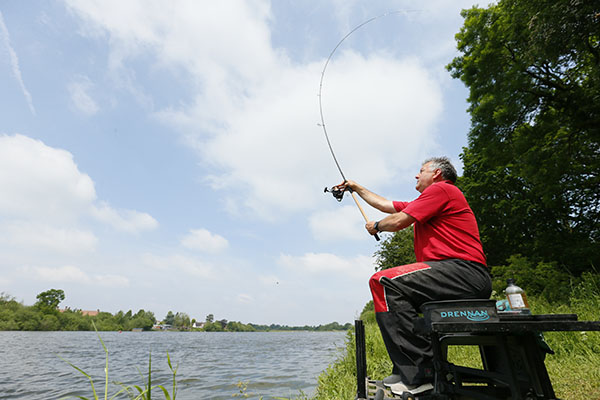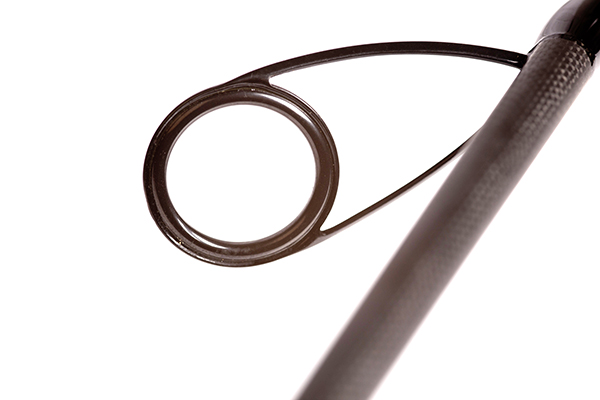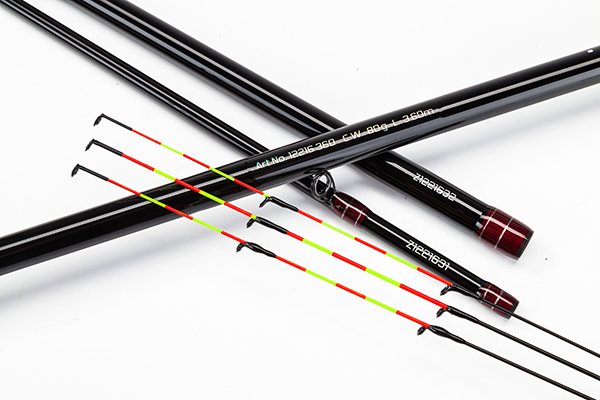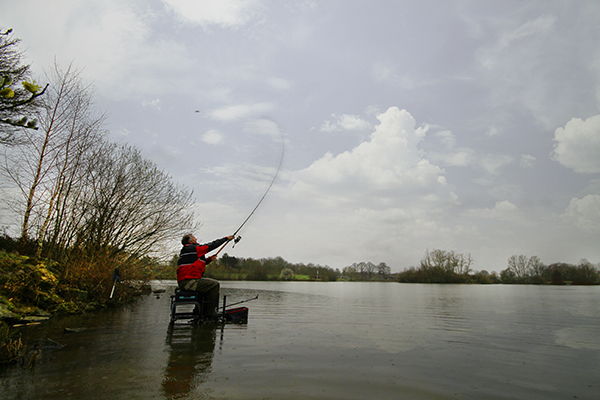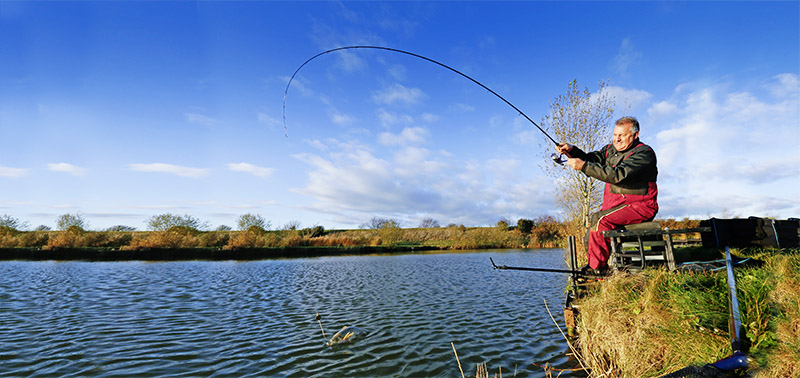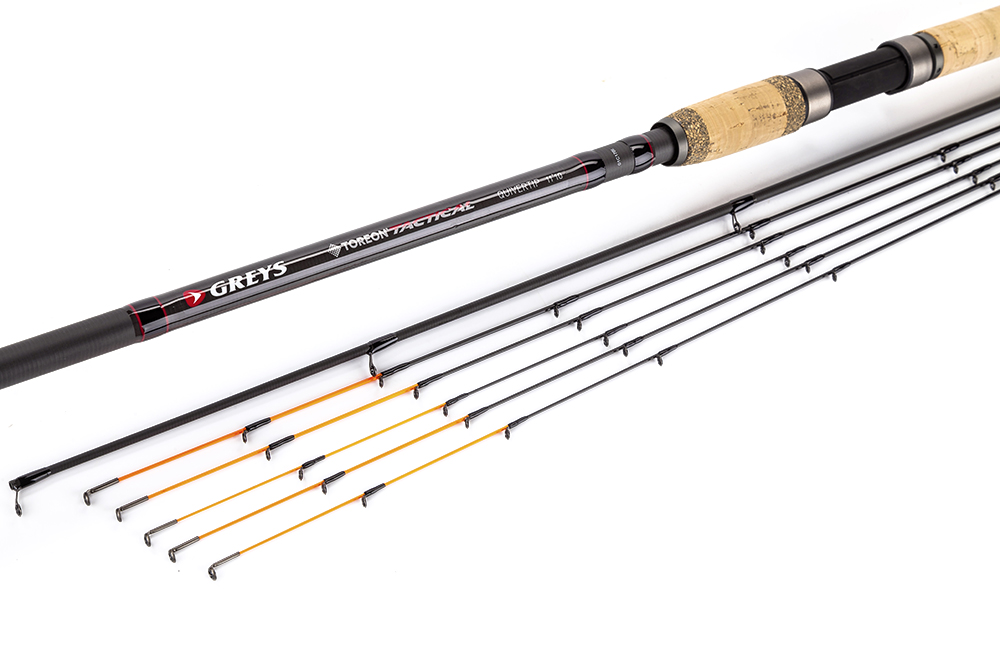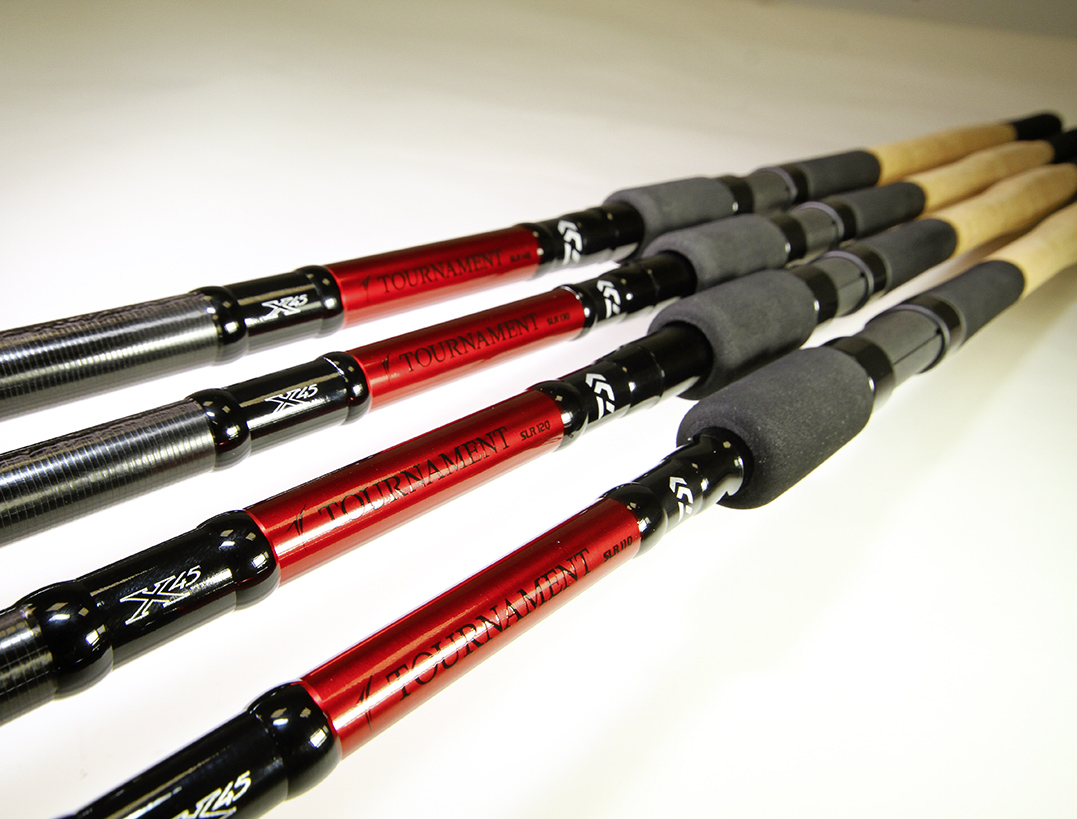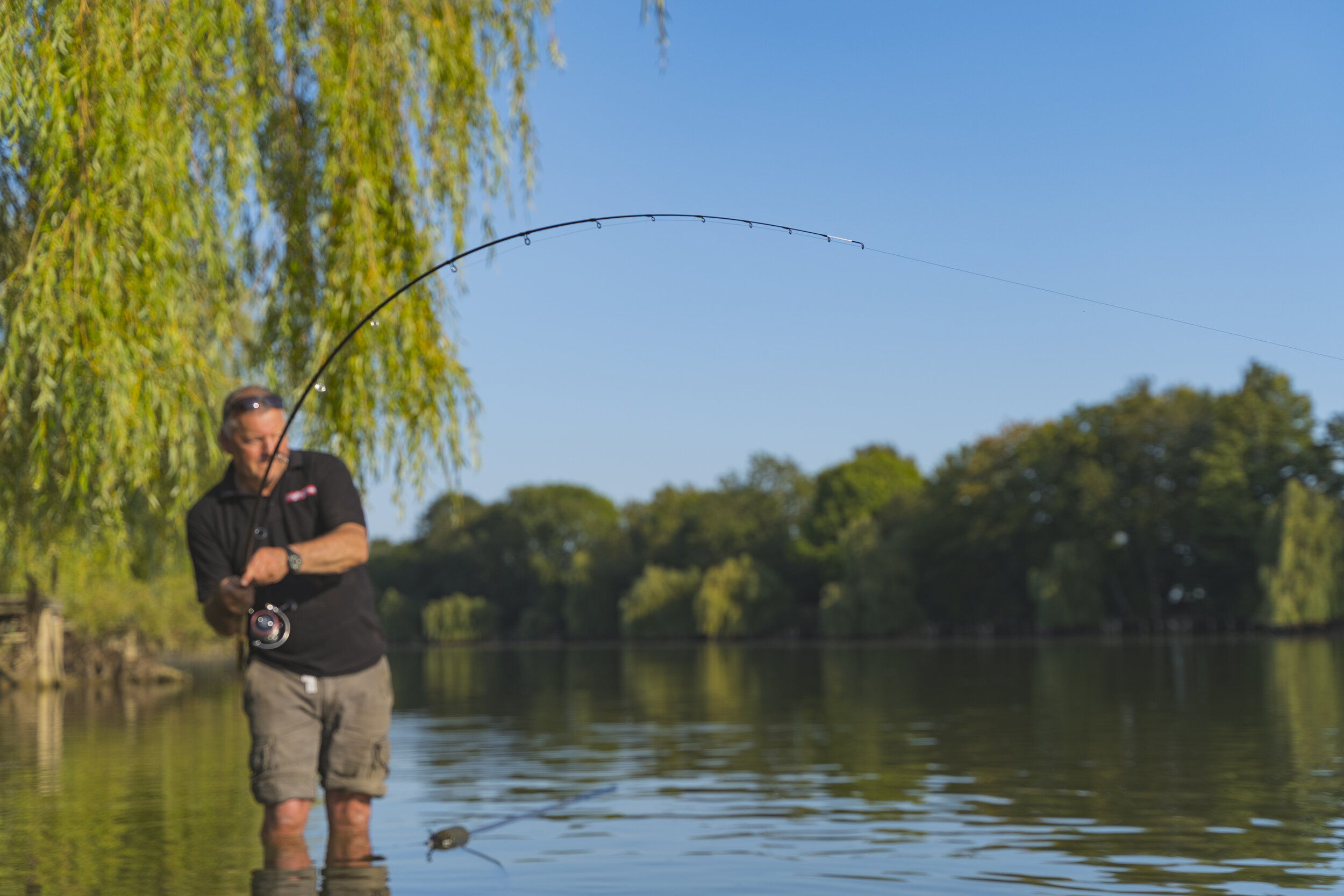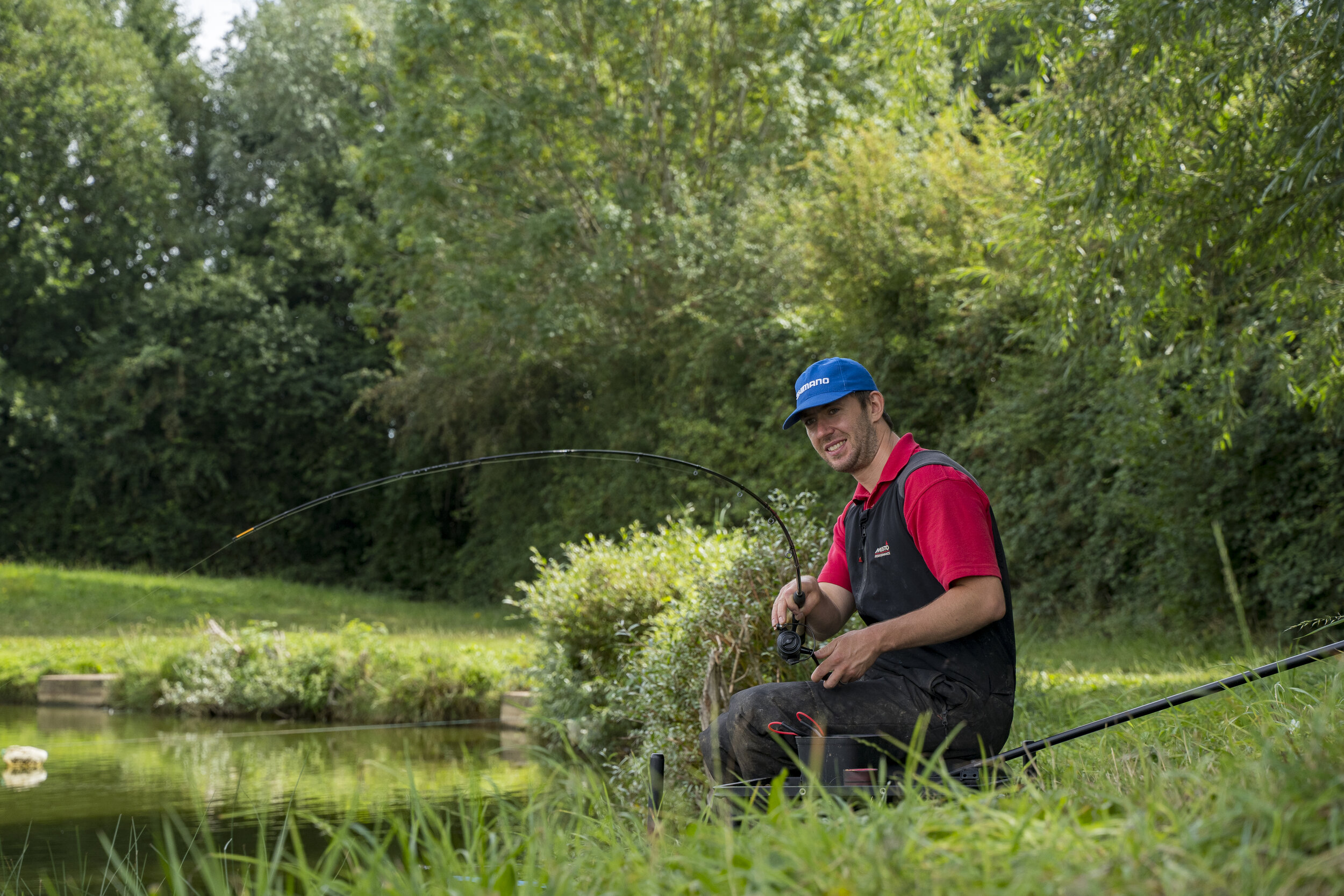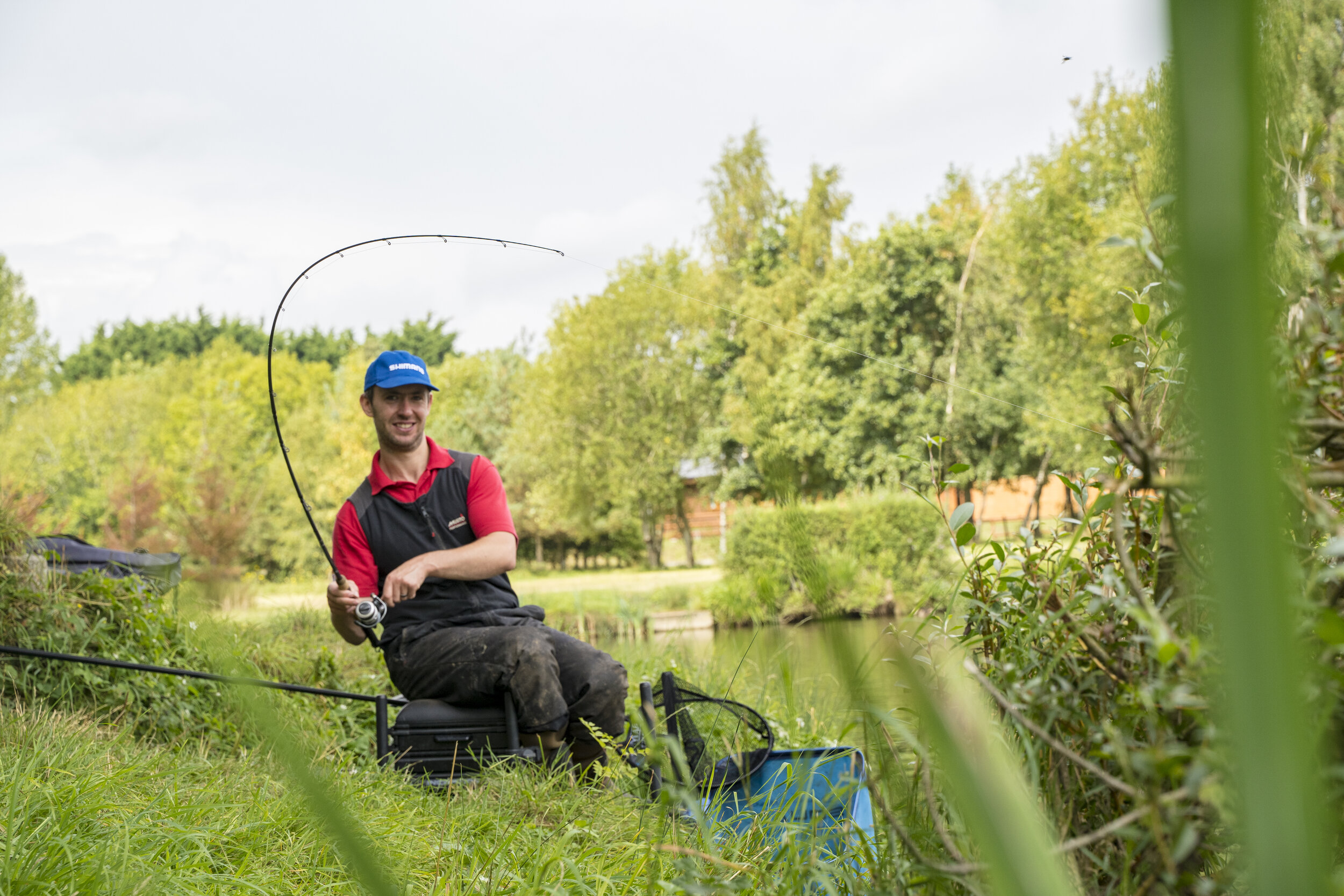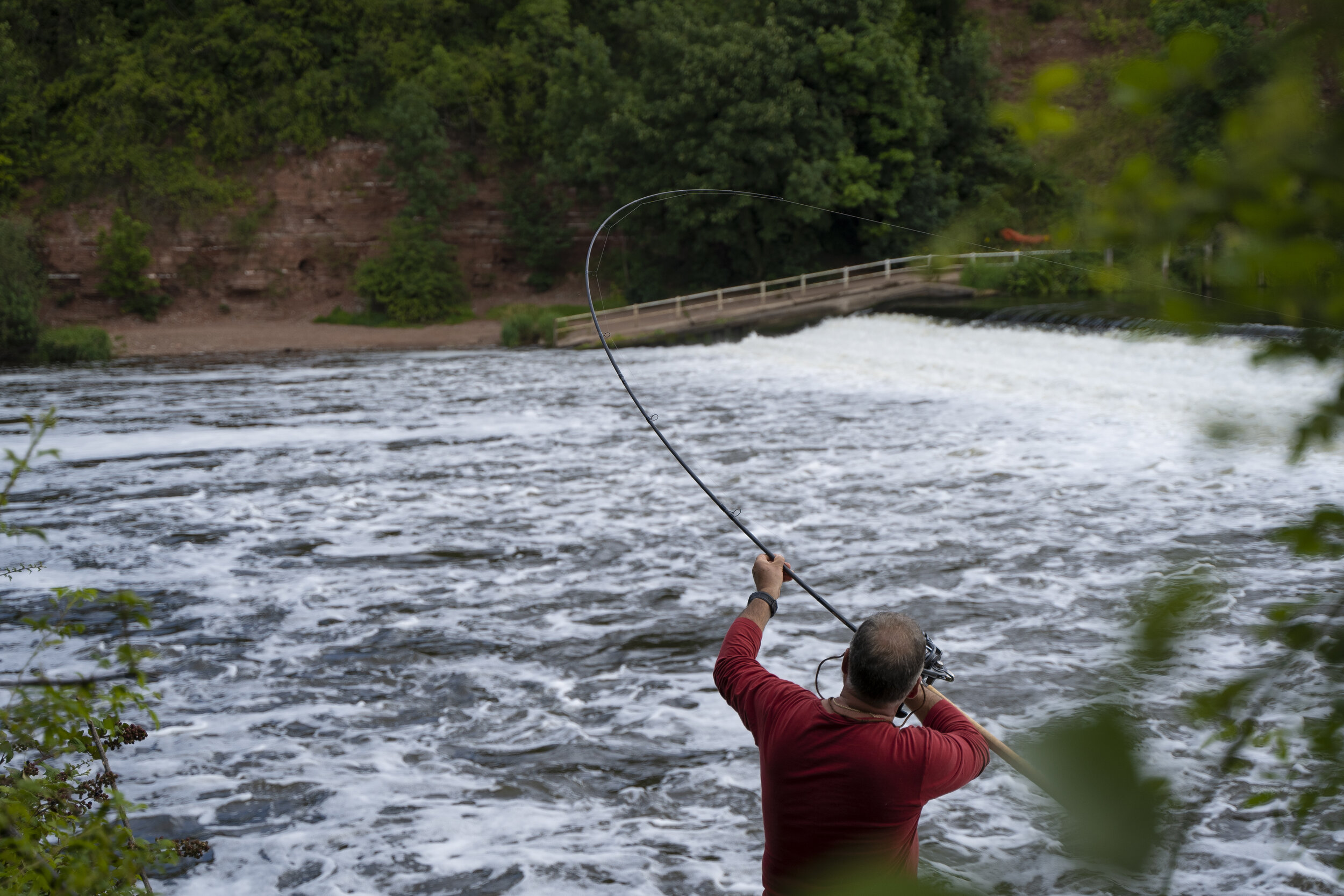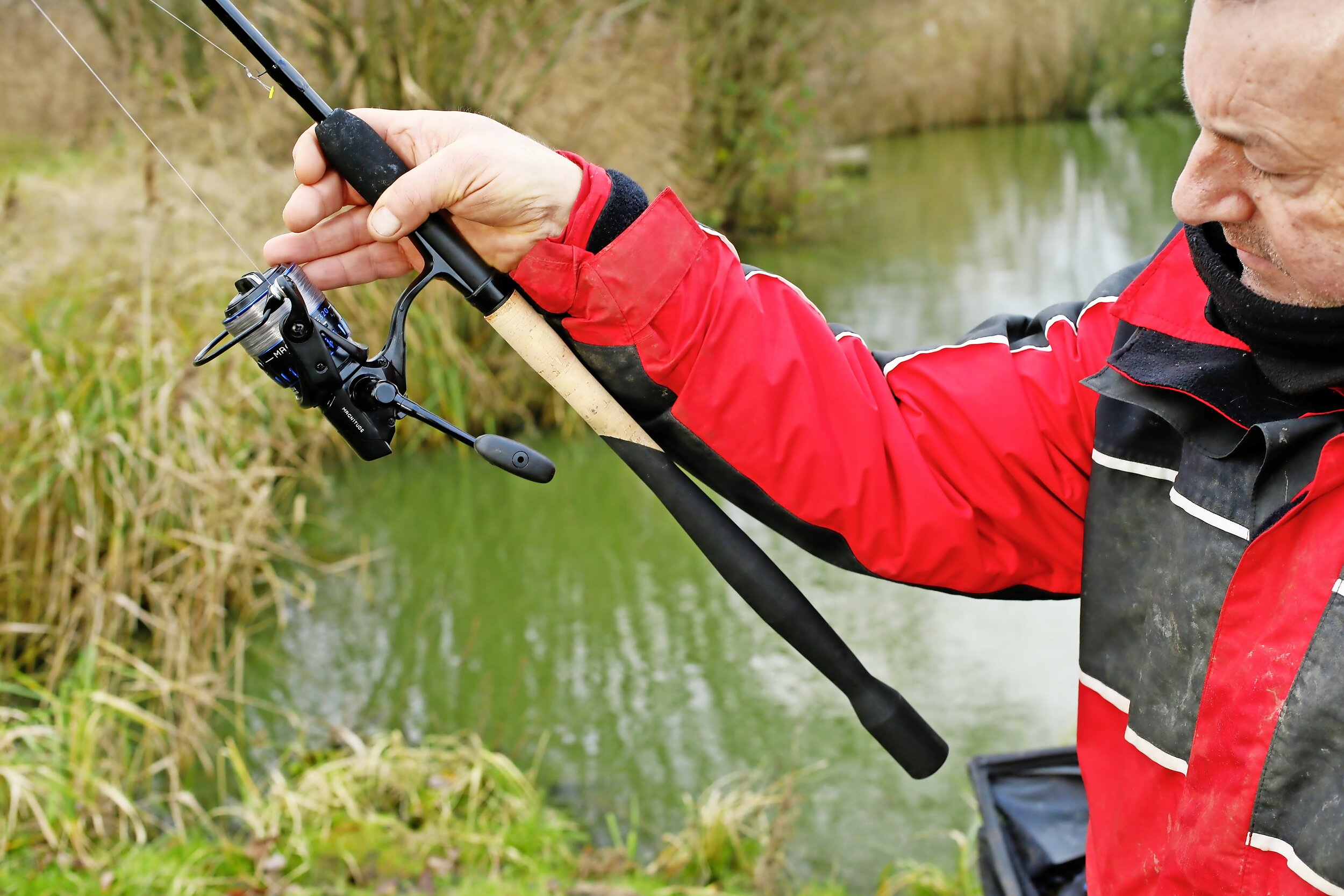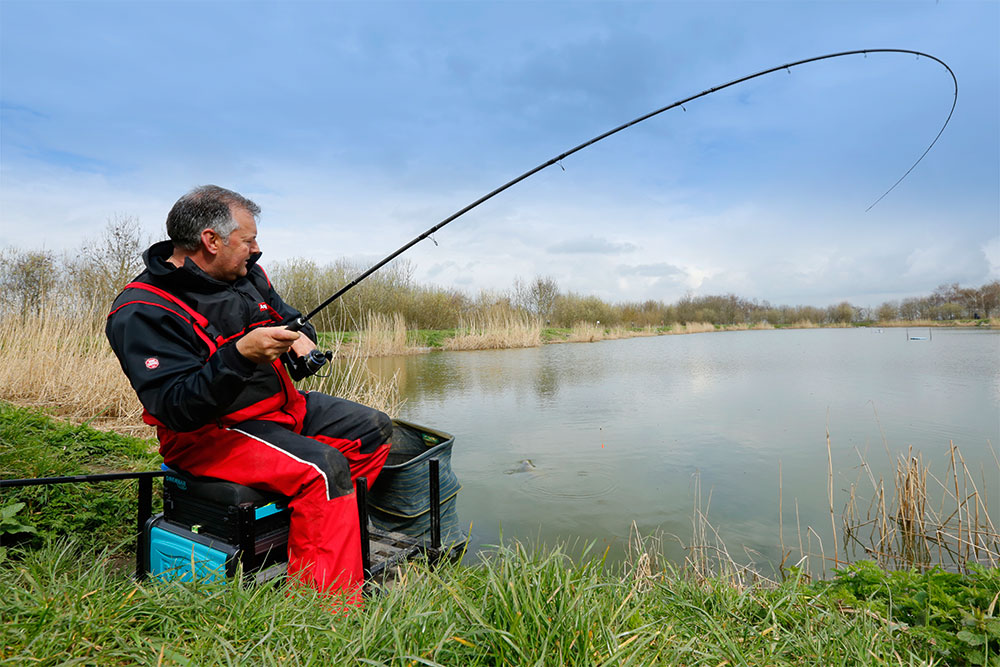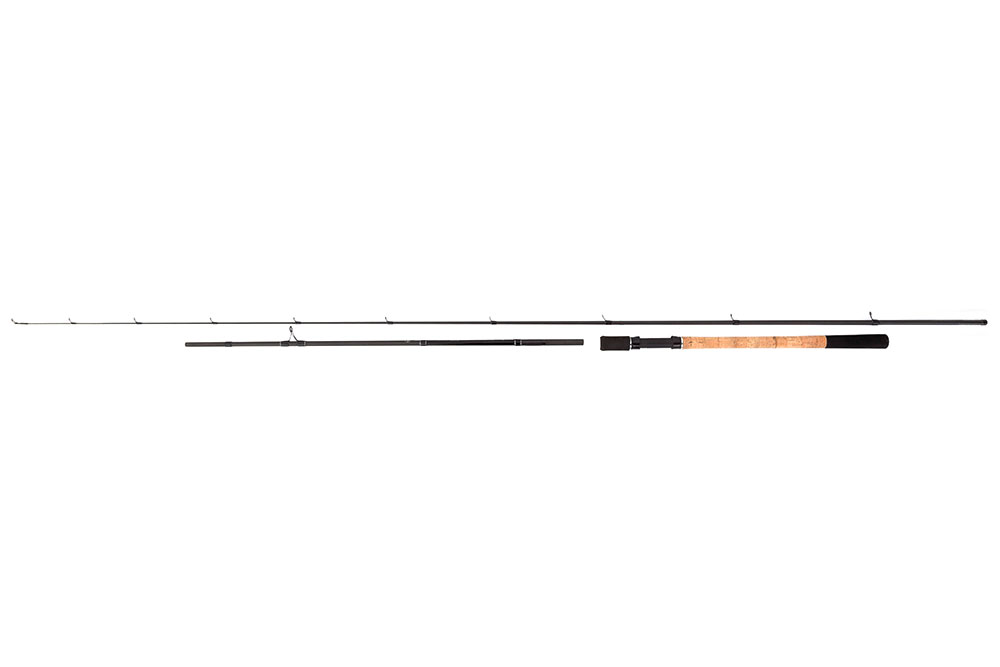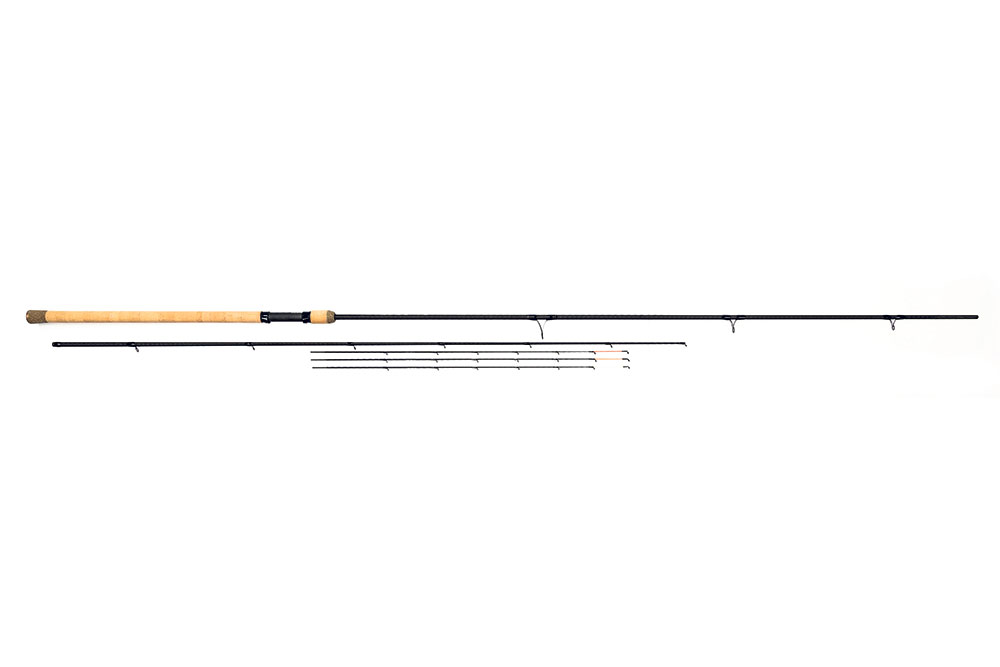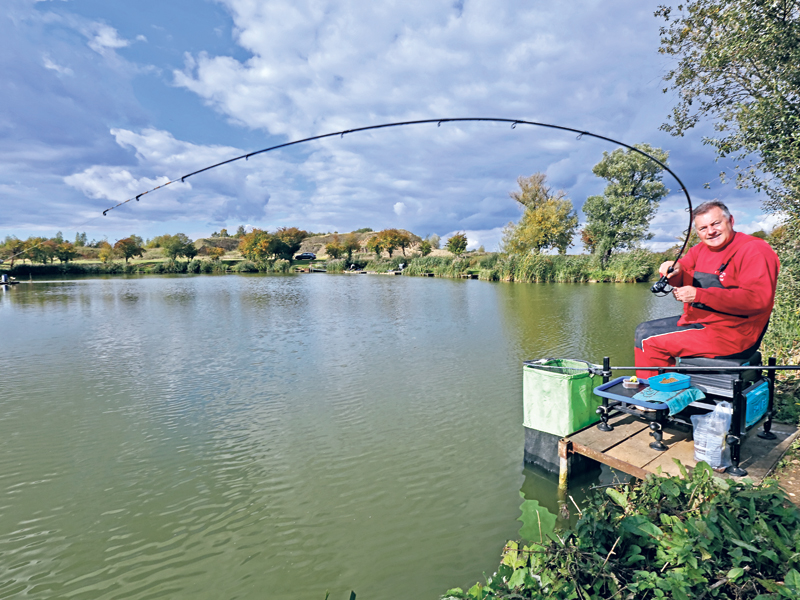Free spirit high ‘S’ Power feeder special 12ft review
Multi award-winning carp rod manufacturer Free Spirit has added eight new Power Feeder models to its top-end Hi ‘S’ match range.
Two years of input from some of the UK’s best feeder anglers have gone into the design of these long-cast rods. Specials are two- and three-piece blanks in 12ft, 13ft or 14ft lengths, all rated to a maximum 120g (4oz) casting weight. The souped-up Distance versions of the Specials will whack out up to 160g (5.6oz) – a really hefty payload.
In terms of build, High ‘S’ Feeder rods are up there with the best. High-end Kigan anti-frap guides and cut-away Fuji reel seats not only give the rods plenty of transmission and feel, but will accommodate larger big pit reels.
All Free Spirits rods are made from super-slim, ‘perdurable’ (non-scratch) Japanese low resin 40-tonne and 24-tonne carbon cloths with a 1k weave, which results in a sensational matt finish.
The blanks boast wickedly responsive casting actions, super-fast tip recovery and ultra-chuckability for bream and carp on big open waters.
Other key features on the new Distance Feeder models include long, hollow quivertips in the same material as the rest of the blank. These ensure a smooth, even power transfer, and longer casts can be made with smaller/lighter feeders. This suits the rods to situations when less feed at long range is called for.
Handles – abbreviated or full cork – are a standard 22ins but can be customised by Free Spirit to whatever length best suits you.
As you might gather by now these are high-class performance rods with a price tag to match, but then the best is never cheap. Overpriced they are not.
For the live test I chose a noted big bream water, Earlswood’s famous Yachting Lake. The bream run large, are no pushover to catch, and are regularly targeted in matches. They tend to feed quite a long way out, making them the ideal subject for live-testing a distance-casting bream rod.
My chosen Free Spirit model was the new two-piece 12ft Power Feeder Special – a first-rate bream weapon with enough backbone to chuck Method feeders at carp.
Put this rod together and you already know you’re on a winner. The sublime slimline blank, with its demure carbon weave and matt finish, is a thing of beauty, while the perfectly spaced Kigan guides add to its aesthetic qualities.
The long hollow quivertips (3oz and 3½oz) arguably add a touch too much stiffness to the action. But in full casting flight you realise that this is all part of Free Spirit’s intended package, a feature clearly adapted from the company’s distance casting carp rods.
The Power Feeder whacks out any type of feeder with no tip bounce, and indeed instant tip recovery. Cast, my word it certainly can cast…. 30g weights don’t even register on the blank, 40g weights power out without a hint of a wobble, while 50g weights, thanks to the blank loading quite high on the second section, still get blitzed.
I stopped at that weight, wanting to concentrate more on the fishing, and getting a feel for how the blank copes with bin-lids on match tackle. My set-up was a 10lb fluorocarbon shockleader to a 5lb reel line, a 0.17mm hooklength and a size 14 hook baited with two small pieces of worm.
Not a single fish was lost during the test, and a progressive action decidedly on the tippy side was no problem. The rod has enough cushioning through its mid-section to cope with headshakes and last-minute lunges without the hook pulling.
Verdict
Expensive, yes, but if you’re seriously into your distance bream fishing this rod could be for you. Classy looks and furnishings are matched by a high-octane casting performance that may well give you an added edge.
I would have been happier with a 2oz quivertip, but having spoken with Free Spirit’ boss Simeon Bond I’m told that these will be available very soon.
Price: £339.99
BROWNING HYPER CARP METHOD RODS review
Just before Christmas I was privileged to visit Browning’s German HQ and give their four new Hyper Carp Method rods a waggle.
Right away I felt these would be perfect for commercial fisheries back home, although at the time Browning seemed uncertain whether they would be available in the UK. However, I banged on and on to the company to release them, and to send me a couple of samples in for a live test. These the makers eventually did, so now I can deliver my verdict.
Now, Browning’s Sphere feeder rods are among the best money can buy, and these Hyper Carp Method rods are not a poor man’s version of these. They have an altogether different feel and action. There’s enough flexibility in the blank to pan large skimmers and bream without fear of hook pulls – the cushioning effect kicks in high up on the second section. This gives the mid-section a good deal more backbone, which you’ll really appreciate when the rods are being stressed to the limit.
All this and more I was to discover at Clattercote Reservoir, whose resident carp were wide awake and raring to go. My chosen rod from the Hyper Carp Method range was the 12ft version, which I reckon to be the pick of the bunch. With an 80g maximum casting weight, it has the length and three-piece build specification to launch a flatbed Method feeder a very long way. In my hands, however, it felt most at home with feeders up to around 40g.
The guides (including those on the quivertip) have sufficient inner diameter to allow the safe passage of 10lb shockleaders, which you need on most feeder venues requiring a mega-chuck.
Well, I hear you say, there are already dozens of long cast feeder rods on the market. What makes these from Browning so special?
For a start, the Hyper Carp Method will cope with all sizes of carp with some style, yet has enough flexibility to stay in touch with bream and skimmers right up to the net. Distances of 80-100 yards can be reached without you needing to be a tournament caster! And the price is remarkably reasonable for what you get.
The live test, I’m relieved to say, proved that the Hyper Carp Method rods are every bit as good as I’d hoped, and then some.
Once I got used to the blank’s fast taper action I was hitting the reel clip with a loaded 30g feeder at around 80 yards every time from a seated position, while standing up and giving it a proper whack I was getting past 90 yards. That was using a 4000 sized reel without a shockleader. I was left wondering how much further I could push its muscular cousin – the 12ft Hyper Carp Method Distance rod, with its £149 price tag – if it were fitted with a big reel and a shocker! This beast will chuck a 100g feeder with ease.
Back to the rod on test, and its fish-playing action proved remarkable. Even when subjected to huge pressure from proper lumps it showed no signs of locking up. After a few bream had put in an appearance not a single fish of either species was lost – which, as any Clattercote regular will tell you, is impressive.
Our Verdict
The Hyper Carp Method is the best rod of its kind and at its price that I have ever handled.
Okay, the multi-banded Euro colours of the quivertips may not be to everyone’s liking. But I’ll tell you this – you certainly can’t miss them which, to be fair, is the general idea.
This was one of the best live test days I have ever had, made even better by the presence of Mark Eves and Phil Ringer, who are highly entertaining, class angling acts.
Price: £139 (but shop around and you’ll find it cheaper)
DAIWA CAST’IZM 12ft 6ins FEEDER ROD
Now here’s a thing… what do you get if you cross the world’s best feeder angler with the world’s best rod manufacturer? The answer? Cast’izm.
That, for those of you who have had your head stuck in a groundbait bucket for the past month or so, is the name of the new feeder rod range designed by Steve Ringer and manufactured here in the UK by Daiwa.
These all-black beauties kick off with an 11ft 6ins rod capable of casting up to 60g (2oz) and suited to open-end and pellet feeder work, as well as a straight bomb. It will handle commercial carp and silvers with equal panache.
The 12ft 6ins version (on live test duty) is Mr Ringer’s favourite, very much at home on large, open bream venues such as Ferry Meadows and Bough Beech.
Its 80g (3oz) casting band is well capable of handling Method and Hybrid feeders.
After those two come the ‘big boys’ of the Cast’izm range, both really long-distance casters.
The 13ft 6ins rod can handle 100g (3.5oz) and is claimed to chuck more than 100yds, suiting it to rocket and window feeder work where every inch of distance is important. Natural venue species and commercial carp are meat and drink to it.
The biggest Cast’izm, 14ft 2ins long and with a maximum casting weight of 120g (4.2oz), is ideal for big rivers such as the Trent and Severn, and I suspect it will go down well with those who fish matches on the wide and deep canals of the Netherlands.
Despite their reasonable price, no corners have been cut with the Cast’izms. Their latest HVF Nanoplus carbon construction imparts a clean, crisp action, and a rapid tip-end recovery speed adds yards to the cast.
The three-sectioned models all have a carrier section, and to prevent any flat spots at the joints Daiwa has employed its unique V-Joint system that retains seamless and progressive curvature at all times.
Large-diameter K guides help to prevent tangles and speed the passage of line. Interestingly, the three carbon push-in Tournament Distance Tips are graded to match the rod’s capacity, although other test curves are available too. These are exactly the same tips as used on Daiwa’s top-end SLR rods. Enlarged ring diameters prevent tangles and possible crack-offs, and their wide spacing contributes to casting performance.
As for the live test itself, the only thing in plentiful supply was the rain. I knew full well that Ferry Meadows, near Peterborough, had been in poor form since last September but, after all, this is exactly the kind of place these rods are designed to be used at.
The 12ft 6ins Cast’izm fairly sizzled out every breed of feeder known to man. Matched with the right sized reel, it’s a lean, mean casting machine that loads the weight of the feeder high on the blank to keep pre-cast bounce to an absolute minimum. What it’s like to play a fish on I can’t say, as that bit didn’t happen.
As Arnie said: “I’ll be back”… later in the year, when it’s warmed up a bit, and the bin lids are lifting.



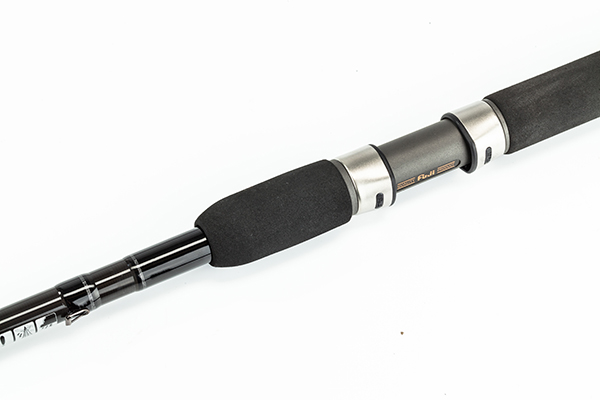
Our Verdict:
These four Cast’izm rods make up possibly the best long-range feeder quartet on the planet. The design influences of a world-class angler are clearly visible.
The right type of guides, and extra spacing between the rings on the carbon quivers, provide fluid casting power. The longer handle gives added speed through to the tip, so even if your casting action is a bit on the slow side you’ll achieve longer distances.
A progressive mid-section action makes the use of reasonably small hooks and lightish lines possible without fear of lost fish.
But there’s still enough severity in the the butt section to deal out punishment to big commercial carp.
What’s not to like? This is a rod fabulously designed and brilliantly built for use anywhere, for everything.
Price: £169.99 (12ft 6ins version)
Daiwa Yank n Bank 9ft Mini Method Rod Review
Yank n Bank is a brand you might well associate with out-and-out hauling power – the name says it all, really.
Yet the latest rods of this ilk to be released by Daiwa are not all in the bruising doorman class.
There are four Match/Float rods, three of which (10ft, 11ft and 12ft) are Pellet Waggler models. The other is a lightweight three-piece 13ft rod aimed at the silver fish angler.
Six Feeder models include 9ft and 10ft Mini Method rods, and of the two 11ft Method Feeder rods, one is a Power model to tame feisty commercial carp.
They are all light in the hand, with a rapid line-pick-up and a crisp, progressive action.
From comments made to me at a recent trade show, Daiwa is expecting great things from these latest incarnations of its famed Yank n Bank rod range.
Sure enough, all 10 rods are a significant improvement on their predecessors (which were themselves no slouches). Certainly the finish is far better than that on all previous Yank n Bank models.
Live testing a rod, no matter how good it may be, always tends to be a hit-and-miss affair in winter – after all, the fish are shoaled up tightly, and can be somewhat reluctant to have a munch.
However, if you can find them you’re always in with a chance, and it was with knowledge gleaned from recent Decoy winter leagues that I knew a few fish could probably be found out in the middle of the Elm strip lake.
That suited me, as I had wanted to get a much closer look at Daiwa’s latest 9ft Yank n Bank Mini Method Feeder rod since first clapping eyes on one. It struck me at the time that it could be the perfect tool for fishing at 18m-25m, just beyond pole range, and be very well suited to taming the odd bigger fish – Decoy has its fair share of these Gruffaloes.
However, there’s a huge selection of short feeder rods out there now, so what would make this 9ft Yank n Bank offering stand out from the crowd?
For starters, the asking price of just £89.99 is pretty impressive, and you’ll be able to get it even cheaper if you shop around.
Technically it’s extremely well built from high-grade carbon cloth, with a one-tonne carbon weave along its classy gloss black butt section.
This combination not only helps to firm up casting distance and accuracy, but ups the weight it can comfortably handle and provides added steel through the backbone for extra fish-playing control.
The geeky stuff does not end there – the blank’s carrier/tip section boasts a low-glare tape finish. This, although completely at odds with its shiny butt section, imparts a light feel matched with a crisper line pick-up and post-cast tip recovery .
To all that you can add quality furnishings such as stainless steel guide frames with lightweight lined guides, aluminium hooded screw-down reel seat, woven carbon butt frame with rubber cap, ready rod carry case, and a keeper ring as a nice final touch.
On the bank, all this carbon alchemy morphs into a pleasingly lightweight tool which is more than capable of casting 30g with little sign of strain.
Casting performance is further enhanced by its high weight loading point – this enables it to achieve pinpoint casting accuracy, ideal for tricky short distance casts to just past the pole-line.
Obviously it is hugely important to keep your feed pattern tight, and the short 9ft rod is perfect for this, enabling you to keep the bites coming once the fish have been located.
The Yank n Bank’s three graded 1.5oz, 2oz and 3oz push-in carbon quivertips are all well matched to Method feeder use (as it name suggests), although the supplied lightest quivertip is just about soft enough to be used in conjunction with a half-ounce bomb.
Personally I prefer the heaviest, stiffest tip for Method fishing, as that way the fish hook themselves.
The fish-playing action is rapidly progressive, with most of its curvature spread across the top couple of feet, very much in keeping with all modern style short rods.
The seeming lack of playing action should not be taken as a criticism, though, as there’s still enough bend in the rod to absorb the lunges of the heaviest fish, with enough cushioning effect not to drop smaller fish.
However, the purist F1 fanatic may find the rod a tad overgunned for hook sizes above an 18, and hooklengths under 0.12mm.
Price: £89.99
VERDICT
If you're in the market for a quality Method feeder rod for use on smaller lakes, or casting just beyond pole range for decent-sized fish, the new 9ft Daiwa Yank n Bank Mini Method is the ideal tool. Surprisingly steely, it will handle the largest commercial carp while retaining just enough softness to make it usable with lighter set-ups for smaller fish.
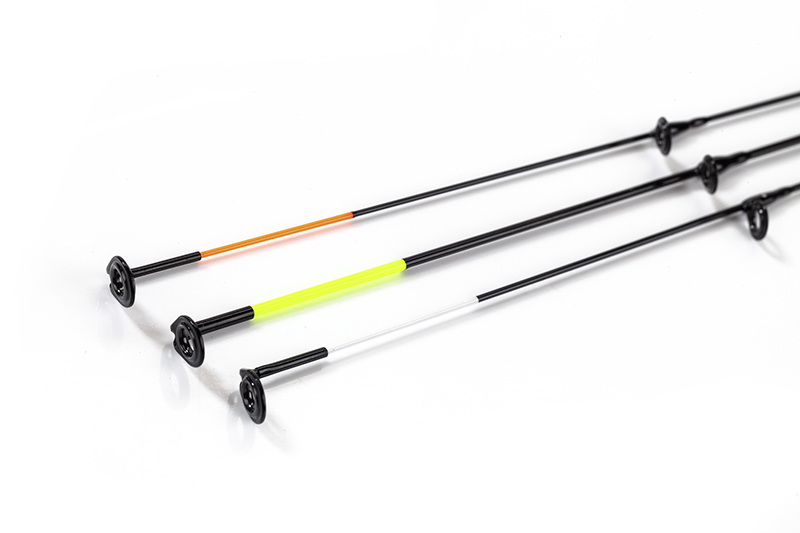


Greys Toreon Tactical Quivertip 11ft 10ins rod live test
Wth daylight hours reduced in winter, many anglers, myself included, much prefer to fish short sessions rather than spend days on end sat in a bivvy and carting mountains of tackle around.
It’s much more enjoyable to grab a rod, a net, a small rucksack and a couple of loaves of bread and wander the banks of your local river searching out a chub or two. The Greys Toreon Tactical Quivertip is the perfect tool for this. It's as versatile as a Swiss Army knife.
There are four lengths available in the range – 10ft 6in, 11ft 10in, 12ft 6in and 13ft – to cater for the needs of every stillwater and river coarse angler. They're just as much at home dishing it out on running water as they are bagging up at your local commercial or lobbing out a feeder on a large natural venue.
For this live test I’d chosen the 11ft 10in version, as at this length it’s a great
all-rounder. It’s just about short enough to creep into tight overgrown river swims, although if this is what you're primarily going to be using a rod for then the 10ft 6in model would be recommended.
This is also long enough to chuck a feeder to islands and open swims on commercials. Unlike most feeder rods, which come with two or three push-in tips, the Toreon Tactical Quivertip comes with five, ranging from 0.75oz to 3oz.
The rod also features a detachable butt grip which not only makes it more compact for storage, but also gives you two handle length options. There are nine lightweight gunsmoke SiC line guides on the rod and six equivalent guides on the five quivertips.
To test the rod I headed off to the tiny River Ise in Northamptonshire. This is a tributary of the River Nene and requires a stealthy approach at the best of times to avoid spooking the resident chub.
The fact that the water was fairly low and clear meant I’d have to be extra stealthy. Tactics were kept simple. My reel was loaded with 5lb mainline on to which I threaded a running link leger stopped by a buffer bead over a small swivel.
A piece of breadflake was pinched around a size 10 hook and cast into a deep pool between two shallow stretches of river. I'd baited the mouth of the pool and a couple of other spots along the far-bank reeds with a couple of small balls of mashed bread.
The first few spots didn’t produce a single knock, but a cast towards an overhanging tree saw the tip tremble before it pulled around in a classic chub bite.The fish was quickly steered away from the branches and, after a couple of jagged lunges, a small chub, was drawn over the landing net.
The next two casts produced a couple more chub of a similar size.
THE VERDICT
At almost £140 there are certainly plenty of cheaper rods on the market. But when you look at what you get for your money I think this rod is worth every penny. If you do a spot of river fishing, as well as the odd session on a commercial carp water, and enjoy feeder fishing for bream, it will cover the lot. And the range of five tips supplied with it really do make it suitable to a wide range of duties.
James Furness, Editor, Improve Your Coarse Fishing
TECH SPEC
Length: 11ft 10in
Pieces: Two
Tips: 0.75oz, 1oz, 1.5oz, 2oz, 3oz
Handle: Full cork
Reel seat: Screw lock
Guide type: SiC
Hook keeper: Yes
Daiwa Tournament SLR Feeder fishing rod range
The most talked about rod-range of 2018, the Tournament SLRs are already winning fans in the feeder market, most notably Angling Times columnist Steve Ringer.
SLR stands for Super Long Range and these four blanks are the next step up from the original Tournament distance models designed for the European market. With natural style and long range feeder fishing enjoying such a boom again in the UK now too, Daiwa has tapped into this market here, with spectacular results.
Built using Daiwa’s latest X45 carbon technology, these rods feature distinctive red butt section artwork, a boat load of power to cast even the shortest 11ft version a long way, and a fantastic progressive curve for playing fish.
The rods were designed and tested by Steve himself, who described the 12ft version as “the best rod ever”. A 13ft and a 14ft complete the range for extreme distance or big river work.
Other features include Fuji Alconite guides, a Fjui reel seat, dedicated 70cm carbon quivers, Bias Carbon V-Joint, an Armlock handle, a hook keeper and a new 1.5oz quiver on the 11ft model.
Granted they don't come cheap but if you want total perfection than you're going to have to pay for it and the £400-plus price tags reflect this.
PAY AROUND
£405 - £472.50
Maver Diamond Feeder fishing rod review
SHORT feeder rods are still very much in vogue on commercial fisheries and the 10ft 6ins version of the new Maver Diamond Feeder rods are no exception.
BUY NOW from £179.99 from Chapmans Angling
Super-accurate on the cast, they can be tucked down the side of a platform out of the wind, and are that bit easier all round to handle when elbow room is at a premium.
Provided you’re not faced with a seriously long chuck, rods like this will cast far enough to put you on the fish on most commercials. And, needless to say, they are ideal for Method tactics in the margins where really big fish are about.
Maver’s latest Diamond Feeder 10ft 6ins rod, in two sections, is the perfect length for most commercial feeder and straight lead tactics.
It’s one of four in the range, all boasting high-modulus carbon, cork handle with EVA casting and thumb grips, low-profile lined ceramic guides and the ever-handy folding keeper ring. You also get three graded carbon quivertips.
Unlike a number of other shorter rods that I have tested, Maver’s 10ft 6ins Diamond Feeder has the casting clout to propel a 30g flatbed Method feeder a decent distance with a fair degree of accuracy. I proved this during a live test at Decoy’s mixed-stock Horseshoe Lake… and before any of you familiar with this venue clamour that this lake hasn’t got a long cast on it, I also spent some time casting different weights and distances on the much larger Beastie Lake.
My findings weren’t all that different from Maver’s recommendations, but in my opinion the blank’s limits are being pushed with anything over 60g (2oz) chucked 60 yards.
To be honest, that’s more than enough power and distance for most day-ticket fisheries. A huge plus point is the rod’s non-locking, progressive action with no flat spots.
As you can see from the picture, it tightens up really quickly from a third of the way down the top section, putting you in command when a fish is at the net.
Despite this the rod is not overly stiff, and you’d need to be really clumsy to suffer many hook-pulls. As Dame Shirley Bassey sang, ‘Diamonds are forever’…and sure enough, this rod’s a keeper!
THE VERDICT
The delightful jet black Diamond Feeder gets a huge thumbs-up from me. It’s everything you could wish for. It’ll cast a fair distance when you need to, it’s super-accurate at short range, and it can be used with a wide choice of weights for tactical flexibility. At just 181g it’s very light, and its progressive action combines controlled pulling power with enough softness to make it suitable for reel lines from 4lb to 8lb, with hooklengths down to 0.12mm.
Mark Sawyer
Sensas Black Arrow feeder rods
The Full Range
Black Arrow 800 Feeder
11ft medium – £179.99
12ft medium – £189.99
13ft medium – £199.99
13ft medium/heavy – £209.99
14ft heavy – £229.99
14ft super heavy – £249.99
Black Arrow 500 Feeder
9ft medium – £129.99
10ft medium – £139.99
11ft medium – £149.99
12ft medium – £159.99
13ft medium – £169.99
Black Arrow 300 Feeder
9ft medium – £59.99
10ft medium – £69.99
11ft medium – £79.99
12ft medium – £89.99
Feeder fishing has seen a massive upsurge in popularity, and nowadays the well-prepared match angler has a rod in his holdall that suits every eventuality.
Much of the fervour associated with all things feeder fishing is down to our friends from the Netherlands, who have made the tactic an art form.
Little wonder, then, that one of the largest Continental tackle and bait companies, Sensas, has brought out what looks to be the most comprehensive range of feeder rods yet under the name Black Arrow.
There are 15 rods in all, in three price bands – the 800, 500 and 300 series. The rods are built from Nano-Flex carbon and all blanks are furnished with quality ceramic-lined guides and supplied with three push-in quivertips, graded to suit the various test curves.
Sensas has achieved the perfect combination of power for casting with softness at the fish-playing stage, and running the gamut of slender 9ft light feeder models through to hefty 14ft super rods for long-range chucks on big lakes and rivers, there’s something for everyone.
Drennan specialist tench and bream rods Mk2
Drennan Specialist Tench and Bream Rods Mk2. The pursuit of tench is the ultimate angling idyll. Imagine an early morning walk to the lake through dew-heavy meadows painted with golden shafts of sunlight.
BUY NOW for £129.99 at Amazon.co.uk
Your every step is softly placed, lest the grass underfoot snaps with thunderous disapproval.
The dawn chorus quietens for a moment, then strikes up again – if the birds don’t know you’re here, no-one does.
The lake’s lily beds, bedecked with white and red flowers, are in stark contrast to the peat-stained water. Their stems twitch and bob, revealing tell-tale signs of fish movement below...
Romantic as such images may be, the fact is that modern-day tench fishing (especially for specimen-sized fish) is more than likely to be on a large open-water gravel pit. Such a place was where lifelong tench angler Peter Drennan developed so many of the tackle items and accessories that we all take for granted today.
Yes, the enigma of tench fishing has been the mother of tackle invention and innovation for many years.
All this brings me nicely to these two new MkII Specialist Tench and Bream rods from the thoroughbred Drennan stable. The original models were built for the discerning big-fish angler way back in 2009. These new 12ft, two-piece versions come with 1.75lb and 2lb test curves, and are easy to carry ready made-up.
They boast high modulus carbon build, quality SiC guides, original Fuji DPS reel seats (which can be used with all but the very largest reels) and a stylish anti-flash matt green paint finish.
But other than sharing furnishings and fittings, these two rods are as different as Chavs from chaffinches, as I soon found when live testing them on a free-to-fish public gravel pit in the middle of a Peterborough housing estate.
On a wild, windy and cold May afternoon, the Method feeder was my only option. I had originally harboured notions of using the lighter of the two rods with a big sliding float, just as I fished Gloucestershire’s tench-prolific South Cerney pits back in the day.
However, the hoolie blowing straight down the lake put paid to that trip down memory lane.
So, with the rods set on alarms, it was time to start. My set-ups involved 2oz and 3oz E-S-P flatbed feeders, both with fake corn hookbaits. The lighter 1¾lb model coped well enough with 2oz of casting weight, but that’s pretty much the limit of its chucking abilities, in my opinion.
It’s quite soft-actioned for its test curve, and the guide spacings lend themselves better to lighter feeder and float set-ups than to hurling feeders to the horizon.
It does, though, have a delightful lightness, tactile quality and response, making it ideal for specimen tench or bream, and perfect for the old-school tench angler looking for a super reliable all-round rod.
The 2lb Specialist Distance Tench and Bream model is an altogether more savage beast. Designed for long-range casting, it copes easily with 3oz of lead, and has enough stiffness in its butt section and a high enough weight loading point to blast out a feeder a very long way.
Furnished with larger and fewer SiC guides, this is a very modern tench rod for tackling the largest gravel pits. Both models have similar progressive fish-playing actions although, as you might expect, the Distance rod doesn’t have the same softness or tactile feel. However, having said that the rod is certainly going to provide an altogether much better fish-catching experience for the avid specimen tench and bream angler than they would get from using a distance-casting carp rod.
Angling Times says:
Drennan has clearly thought long and hard about both these rods. The fact that they are basically dressed the same as the originals says much about the popularity of the concept. However, these are specialist rods aimed at the modern specimen angler.
Take your pick between an old school progressive action, with lots of feel and an all-round remit, or a superbly well-built distance casting rod capable of hitting long ranges using heavy leads, and therefore ideal for large expanses of open or weedy water – especially when targeting really big tench.
Price: £129
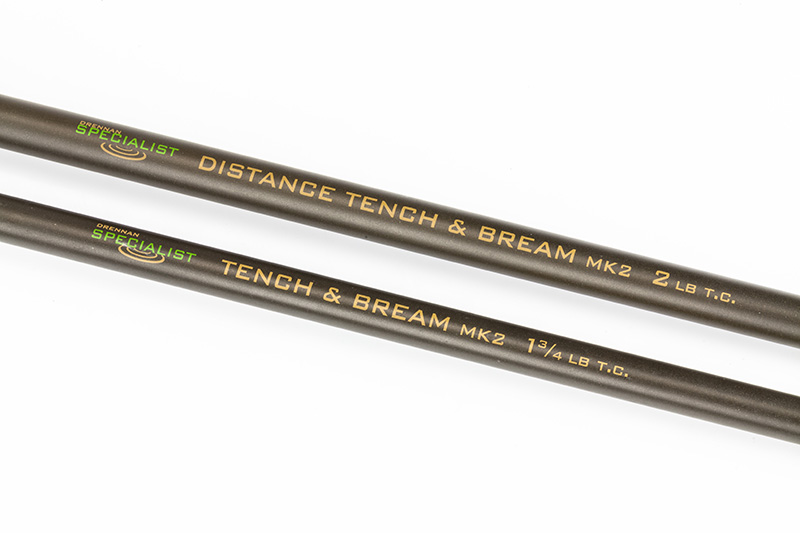



Shakespeare Agility Continental Feeder rod
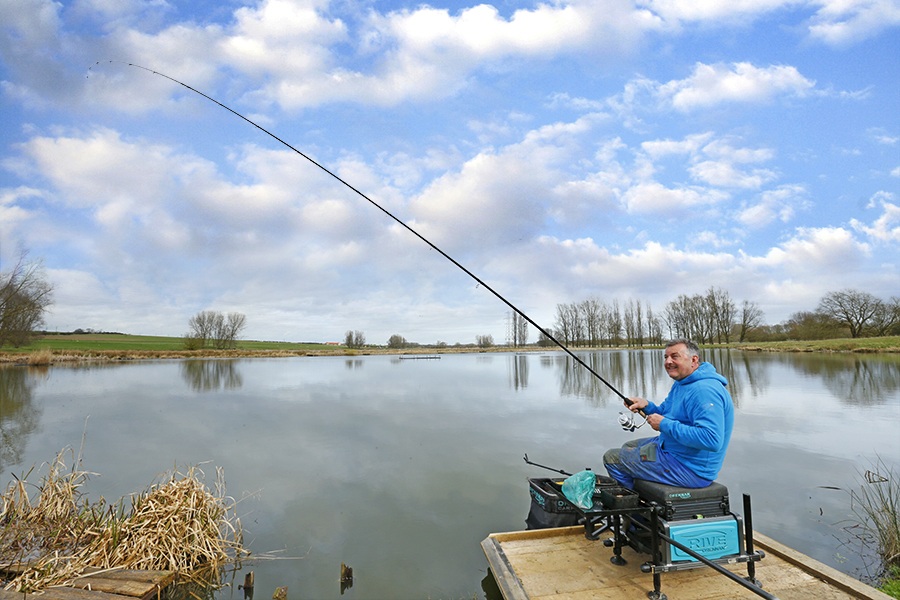

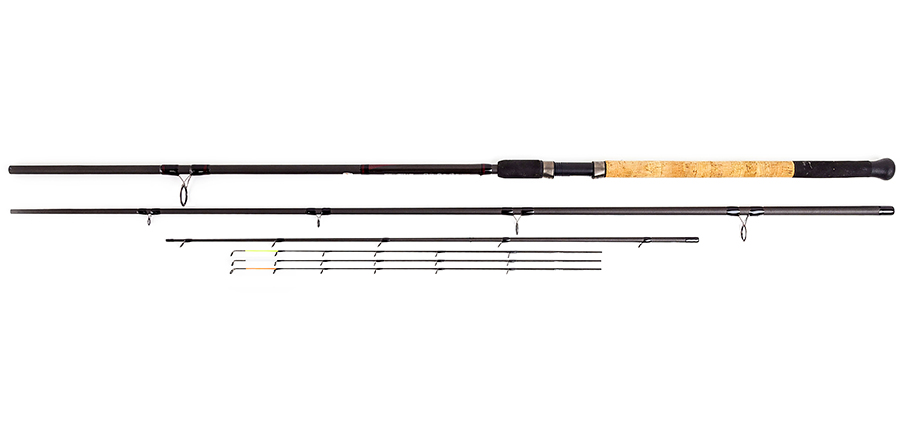
TECH SPEC
Slim carbon blank
Enlarged Zirconium guides
Ergonomically-designed reel seat
Rubber butt cap
Satin matt finish
Maximum mainline rating - 12lb
Recommended maximum casting weight - 5oz
Mono and braid-friendly guides
Shakespeare Agility Continental Feeder rod. This range of continental feeder rods bearing the famous Shakespeare mark is aimed squarely at fans of big, open-water venue fishing.
Designed and constructed to cope with the heaviest of feeders, the fastest of flows and the longest of casts, the rods come in 12ft, 13ft and 14ft lengths and are well-suited to the pursuit of big bream from expansive, deep venues. So why would these rods be of any interest at all to the UK match angler, I hear you ask?
Well I’ll tell you. It was brought to my attention that the 14ft Agility Continental in particular has furtively become one of the most sought-after long-chuck big feeder rods on the market. And not just for targeting stillwater bream either; it’s also rumoured to be very much ‘at home’ on big rivers such as the Severn and Trent. A quick call to Shakespeare revealed my source’s information to be well-founded; the company are currently completely out of stock of the 14ft model, due to an apparent surge in interest. However, the Alnwick-based firm did have the other two lengths in stock, and could get one sent out for live testing purpose immediately.
Although I would have liked to get my mitts on the 14ft model, I wasn’t overly disappointed at it not being available, as I wouldn’t be casting huge distances into really deep water, or using ultra-long hooklengths. A 14ft feeder rod is a highly-specialised tool, and on the rare occasion I have used them - which has been mainly in Holland - they have always felt a little bit alien, so I was more than happy with the 13ft model which I was sure would prove just as good as the slightly longer version.
Two days later the rod dropped on to my desk, and I couldn’t wait to get a look at it. A quick in-office inspection revealed a pleasing matt satin-finished three-piece high-modulus carbon blank. It has been designed with an ‘old-school’ fast-tapering casting action, with more than enough poke through its middle and butt sections to make distance casting a doddle.
Plus, it’s also got a high weight loading point, which kicks in around halfway down the carrier section, meaning it shouldn’t feel wobbly or unbalanced when a heavy feeder is attached to it. Other key features included three carbon push-in quivertips and a superb set of enlarged-diameter Zirconium Oxide guides, ideal for use with all braided and mono mainlines, and certainly wide enough to allow the safe snag-free passage of shockleader knots.
With the river closed season now upon us, I was slightly limited with regards to venue choice, especially as the bream stocks in most of the large acreage open-water venues such as Ferry Meadows are still only just waking up from their winter slumber. However, I knew that the Northants day-ticket lake Rysons was normally good for a few early spring slabs, and as it’s a fair chuck out to the middle of the lake where the fish normally reside, it would prove a fair casting test for the rod.
My set-up involved using a 10lb fluorocarbon shockleader, tied to a 0.10mm braided mainline, with a 40g distance cage feeder at the business end of things. The first task was to lay the table, so I made a dozen quick casts to the lake centre using a big cage feeder loaded with pellets, groundbait and dead red maggots. The blank hardly flexed during the loosefeeding process, with the mainline hitting the clip easily on every cast and the shockleader fairly sizzling through the rod’s enlarged guides. The blank’s casting action is best described as clean and crisp, but if I were to be hyper-critical I’d say it’s maybe a little on the heavy side. However, with minimal recoil, I knew it would be no bother at all to achieve extreme casting ranges.
An hour later the rod’s tip trembled, followed by the unmistakable steady pull-round as a big slab picked up the treble maggot hookbait. Two minutes and two big head shakes later we parted company when the hook pulled out. Unfortunately, this scenario unfolded three more times before a change to a larger hook and a longer hooklength remedied the problem. Quite simply, the blank’s power can be a little overwhelming when used with smaller hooks, but when coupled with wide gape hooks from a size 14 and upwards, the problem pales into the background.
To summarise, the rod has superb distance-casting credentials and is available at a snip of the price of most distance feeder models. As well as being an awesome tool for tackling large stillwaters at home and abroad, it would make an excellent rod for targeting all fish species on our larger domestic rivers.
THE VERDICT
This 13ft Agility Continental has power with a capital P to burn. Originally designed for the European feeder angler, the rod is ideal for big open-water UK venues, and is also sure to find favour with many river anglers, especially where hefty feeders up to 5oz and strong lines up to 12lb are needed. Price wise, for a long-range heavy feeder rod, it’s the best by some margin of those currently available on the market.
PAY AROUND
£74.99
Mark Sawyer
Korum's new range of feeder fishing rods
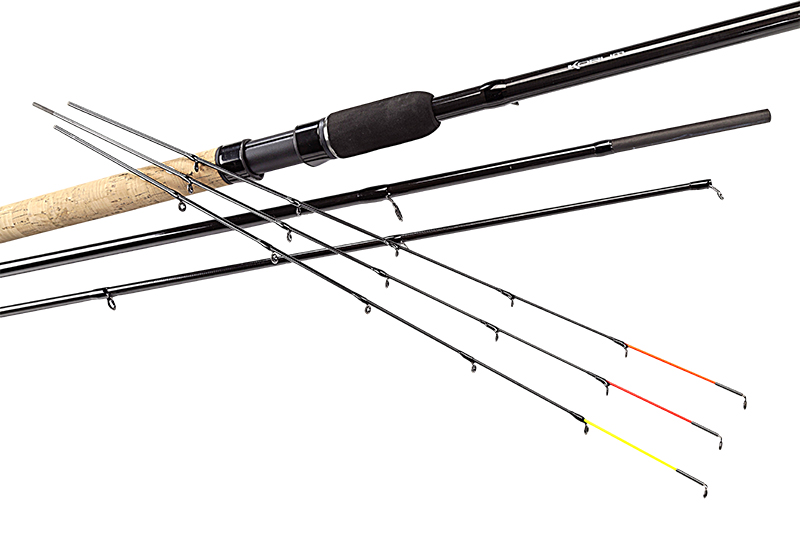
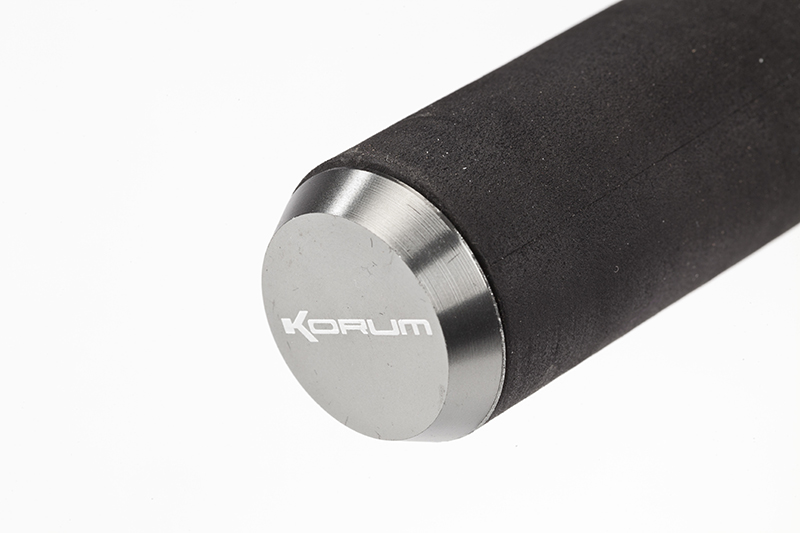
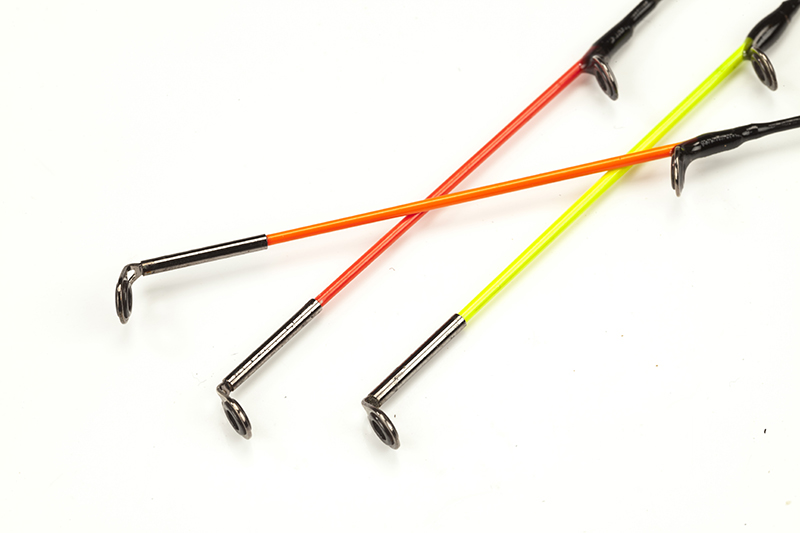

Pleasure and big-fish brand Korum has launched a range of three-piece feeder rods that are sure to be a huge hit. The eight-strong collection features models ranging from 11ft to 13ft, and covers all short, medium or long-casting ranges. The rods are perfect for all types of feeder fishing on both rivers and stillwaters and have maximum casting weights running from 45g to 180g.
11ft Feeder 45g
Ideal for lakes where feeders need to be cast accurately at short or medium distances. A versatile rod with a line rating of 4lb-8lb, it is supplied with three 2.65mm colour-coded quivertips: orange (light), yellow (medium) and red (heavy).
PAY AROUND
£44.99
12ft Feeder 45g
Described by Korum as a ‘fantastic all-rounder’ with plenty of backbone, it has
a 4lb-8lb line rating, and comes with three 2.65mm colour-coded quivertips (light, medium and heavy).
PAY AROUND
£44.99
12ft Feeder 60g
A rod with more power for casting larger feeders and making longer casts. It has
a 6lb-8lb line rating and comes with three 2.65mm colour-coded quivertips (light, medium and heavy).
PAY AROUND
£44.99
12ft Feeder 90g
This rod is for large feeders and long casts, but it retains enough tip sensitivity for silverfish work. Ideal for medium-paced rivers, it has a 6lb-10lb line rating and comes with a trio of 3.3mm colour-coded light, medium and heavy quivertips.
PAY AROUND
£44.99
12ft Feeder 120g
The most powerful 12ft model in the series. A good option for fast water, but with a sensitive tip action that allows plenty of options. It has a line rating of 6lb-8lb and comes with three 3.2mm colour-coded quivertips.
PAY AROUND
£44.99
13ft Feeder 120g
As with the two other 13ft models in the range, this rod has a slightly more powerful tip for improved casting distance and accuracy. It has a line rating of 6lb-10lb, and comes with three 3.2mm colour-coded quivertips.
PAY AROUND
£49.99
13ft Feeder 150g
More power and a faster casting action make this rod ideal for when long casts and heavy feeders are the order of the day. Great for large, open stillwaters and fast-paced rivers. Carries a line rating of 6lb- 10lb and comes with three 3.2mm colour-coded (light, medium and heavy) quivertips.
PAY AROUND
£54.99
13ft Feeder 180g
With a casting weight of 180g, this powerful rod will comfortably launch feeders beyond 100m. Boasting large-diameter guides, it can also be safely used with shockleaders. It has a line rating of 6lb-10lb, and comes with three 3.2mm colour-coded (light, medium and heavy) quivertips.
PAY AROUND
£54.99
Drennan Acolyte Plus Compact 13ft review
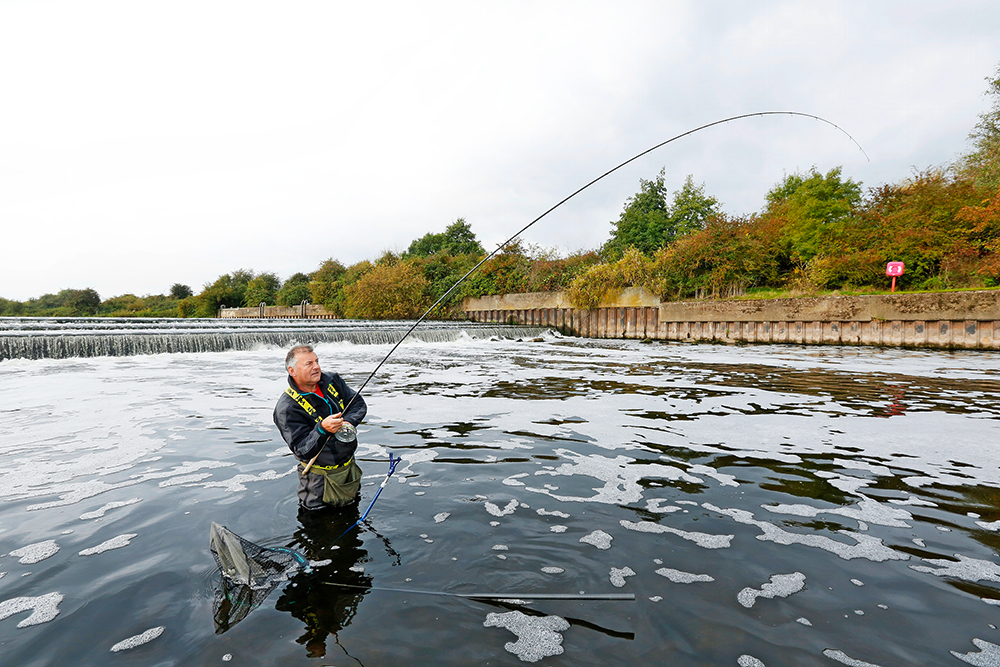
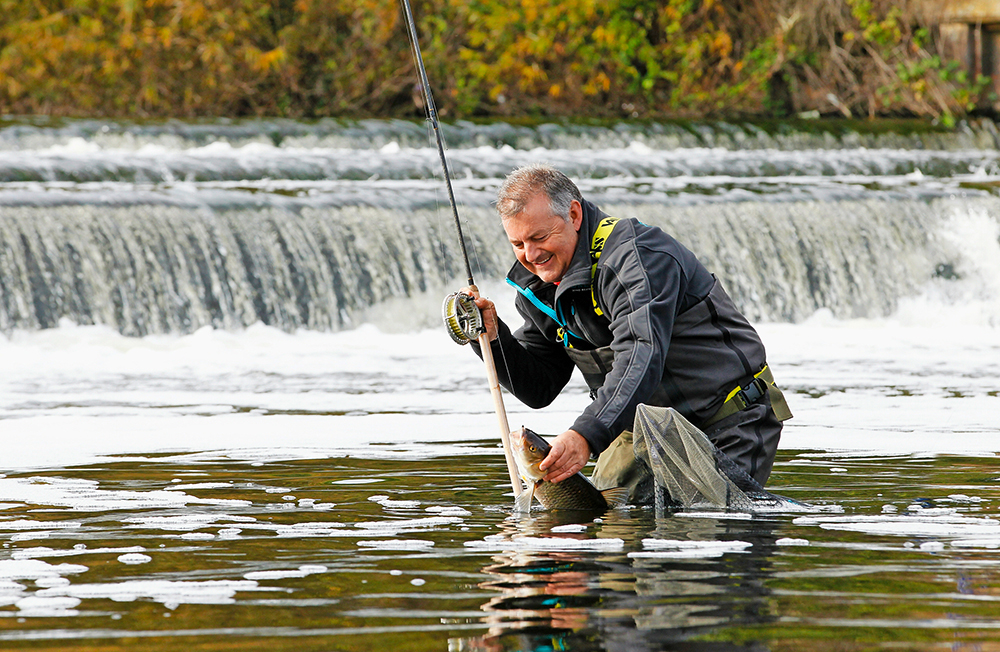
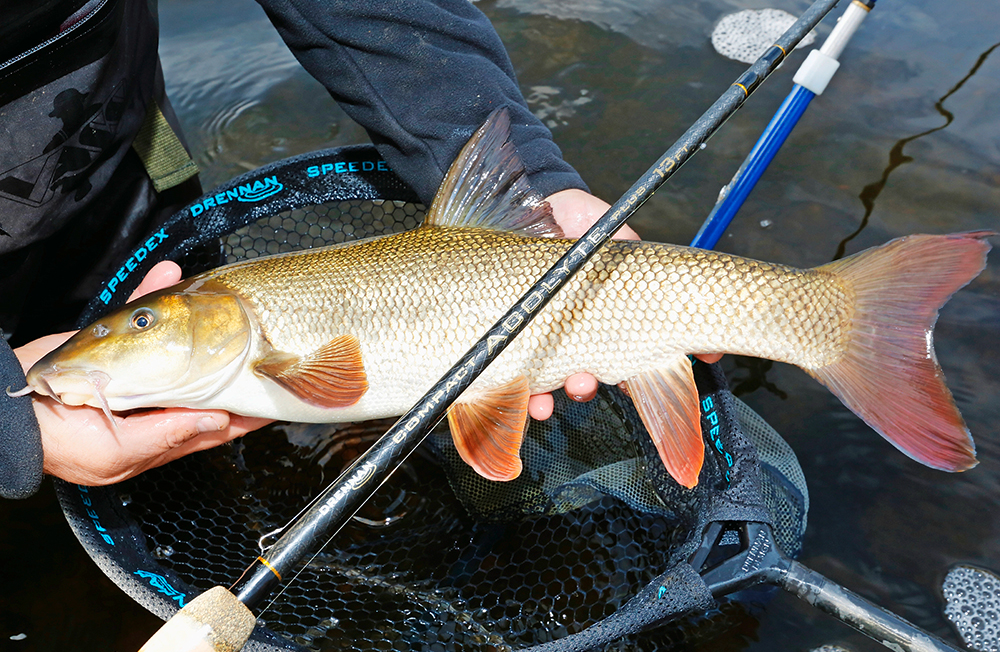
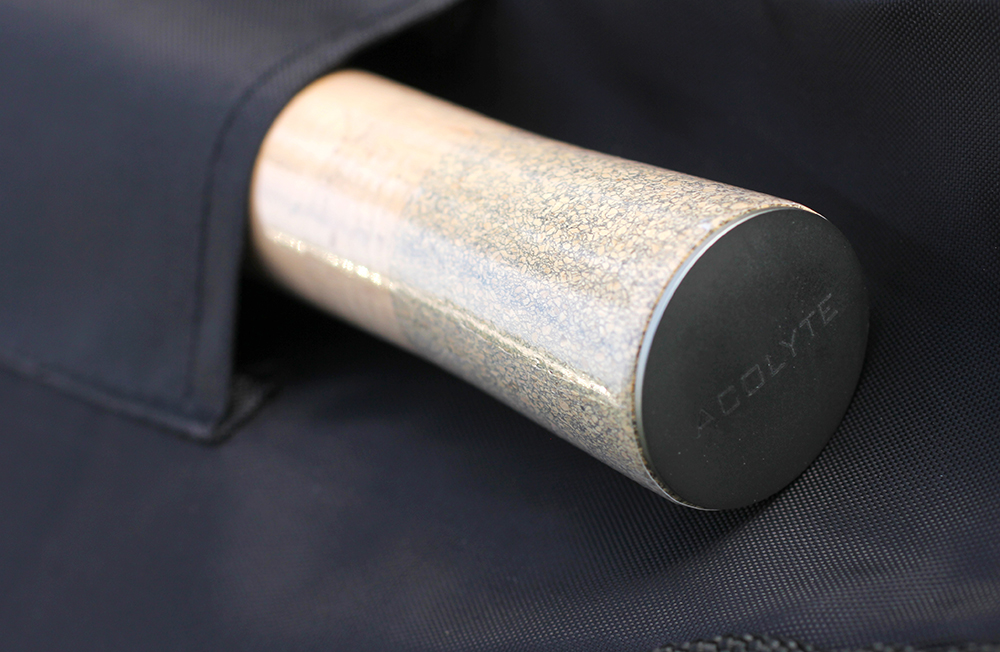
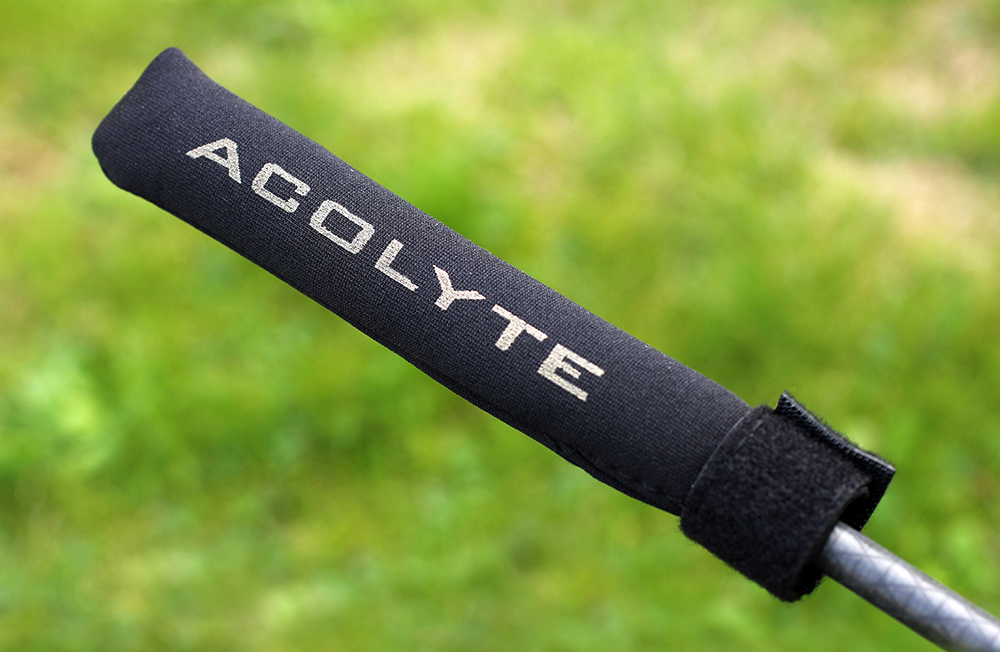
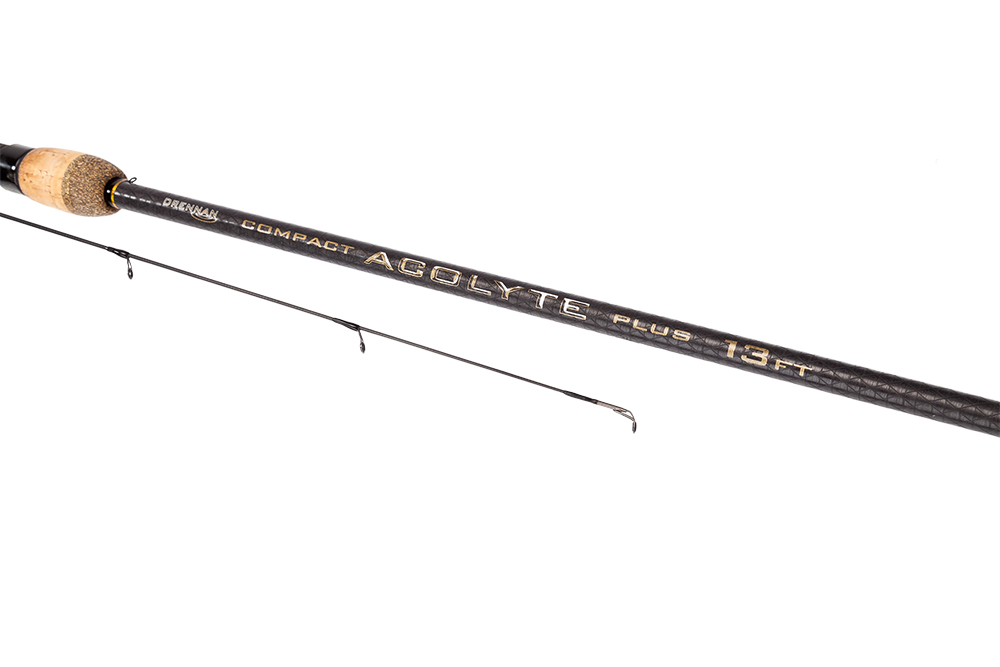
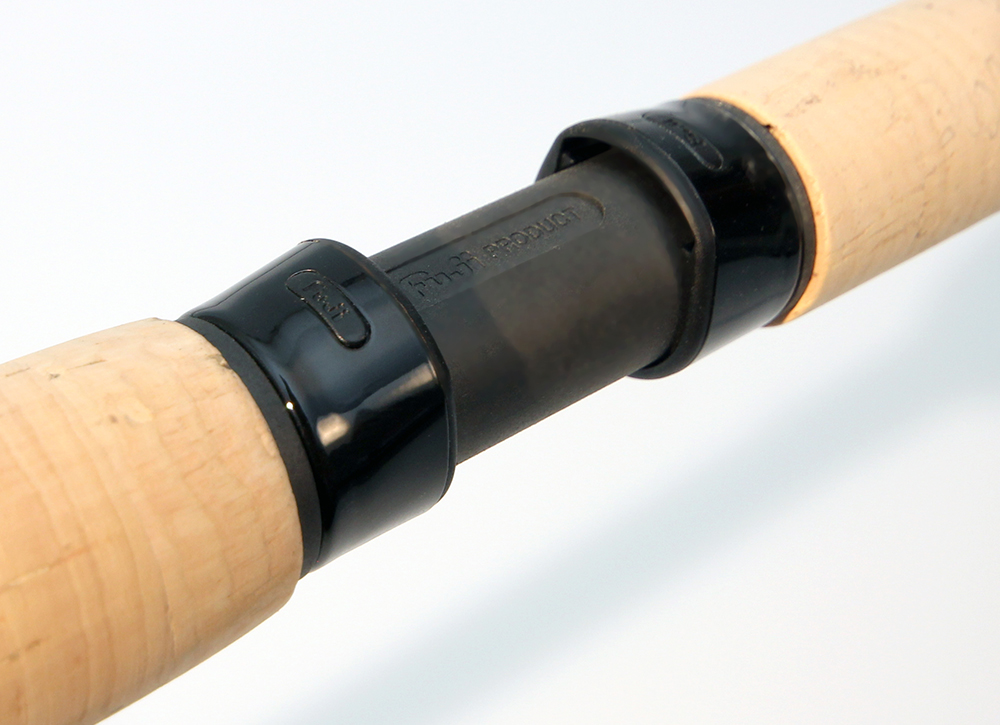
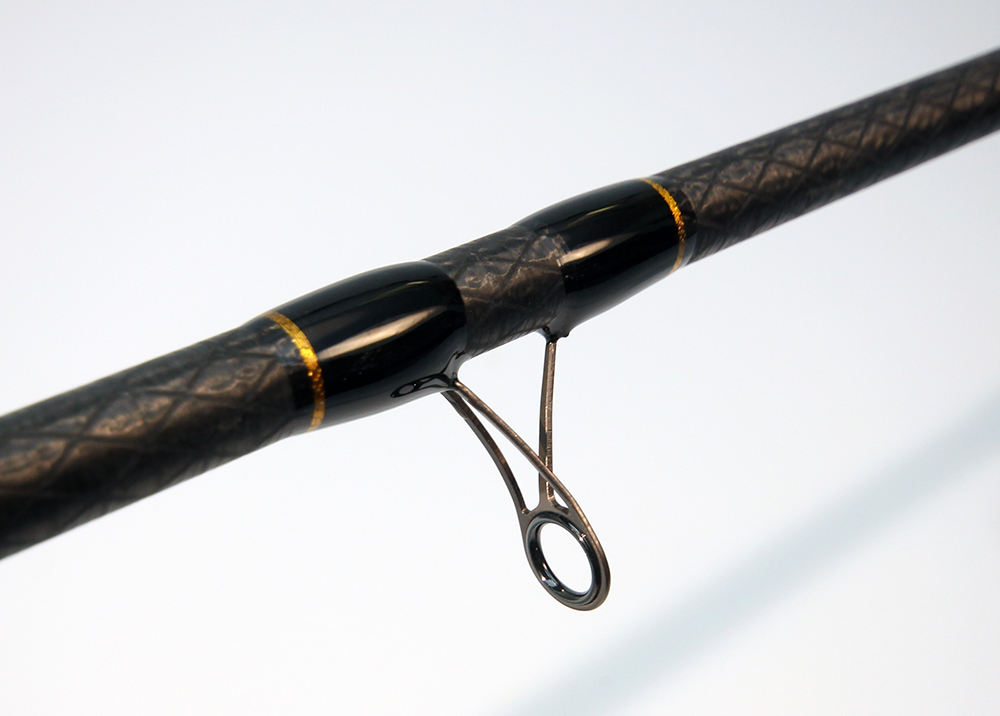
TECH SPEC
Length: 13ft
Pieces: Two
Reel lines: 4lb - 6lb
Hooklengths: 3lb (0.13mm) - 5lb (0.16mm)
Supplied with: Padded rod sleeve, retaining bands and rod socks
PAY AROUND
£209
Widely considered to be the best available, Drennan’s award-winning 13ft Acolyte match rods need little introduction.
The original super-light (4.5oz) Ultra makes floatfishing on rivers and lakes a pleasurable experience. The rods have a crisp yet forgiving action teamed with a viper-fast striking speed that can still set a tiny hook without fear of snapping off gossamer-fine hooklengths.
So, with all the boxes ticked, why would Drennan even think about making changes to these rods? Well, the company has… and yet it hasn’t. Let me explain. For those who prefer the original three-piece Acolytes, these rods remain unchanged and widely available.
However, they have been joined by two new Acolyte Compact versions, the 13ft Ultra and the stepped-up 13ft Plus.
These new two-piece rods have a patented design that enables the bottom 31cm of the handle to be unscrewed, leaving you with two similar length sections that can be quickly, easily and safely broken down with your rigs in situ. That’s never before been possible with 13ft match rods, unless of course you want to risk tip breakages, or spend more time untangling your rigs than setting up again from scratch.
The Compact Acolyte’s two sections are said to actually improve the rod’s balance and action by having just one ferrule in front of the handle, rather than the usual two, and that makes perfect sense.
But rather than simply just take the manufacturer’s word for it we took the Compact Acolyte Plus to the bank to see for ourselves – already all-but convinced by Drennan’s impeccable rod-building prowess.
As with the original three-piece Acolyte Plus model, the new Compact has the power to cast large floats and subdue quality fish. Essentially it’s a stepped-up version of the Ultra, but where would you use it? Well, it’s ideal for all long-range waggler and sliding float work, but legging-up a few skimmers and roach isn’t really much of a live test.
What was needed was a venue where we could use a big float and heavy line to catch something that pulled back – and not a carp!
Waters around Nottingham available on a Scunthorpe AA club book are among the finest on the Trent. So, armed with the Compact Plus fitted with my precious Hardy Conquest centrepin reel and little more than a few top-and-bottom floats, a pocketful of accessories and some bait – not forgetting the waders – I was off to a shallow, picture- postcard stretch where the float rules.
Wading into the shallows, surrounded by white foam created by the crashing weir behind me, I found a flat crease around four rodlengths where I thought the float would pass unhindered over the rocky riverbed.
Feeding Dynamite Baits Hemp with Snails, mixed in with small pieces of the meat carried in my bait apron, I soon realised why it’s important to use a light rod and reel combination. Regular feeding, and constant casting soon take their toll, especially when you’re not used to it.
But I have to say the Drennan/Hardy combination was as light as thistledown, and I fished for several hours without need of a rest. Casting a 4g alloy-stemmed Avon float proved effortless for the Acolyte Plus, and it could have easily handled double that weight.
It also fairly snapped the line off the surface with little more than a flick of the wrist – no great sweeping arcs of strike needed here to hit the bite, as the rod has a super-fast action with virtually no recoil or tip bounce.
I must admit I feared the worst, striking at distance with a two-piece 13ft rod, but my fears were groundless – it’s just perfect.
But the rod’s crowning glory is its awe-inspiring parabolic action. Its top section has a cushioning tip that tightens further down to generate a ‘power play’ fighting curve quite capable of handling the largest of fish.
That was proved as some whacking great chub and ‘never say die’ barbel were beaten in white water – after putting up the kind of scrap that would have given most other rods one hell of a beating!
VERDICT
Well, I’ll keep this short. During the live test I did lose a few fish, all very big barbel. It had nothing at all to do with the rod, it was simply poor preparation on my part, as I hadn’t loaded my reel with a heavy enough line.
This episode played on my mind all week, so I simply had to return and have another go. Reloading the reel with something more substantial, and re-rigging the rod at home, meant I could safely carry the made-up rod in the car all ready to go.
The result was my biggest-ever barbel on a float rod, estimated at 10lb-12lb. It fought like a demon, and no wonder I shall be forever grateful to Drennan’s new Compact Acolyte Plus.
Browning Commercial King2 Medium Pellet Waggler rod
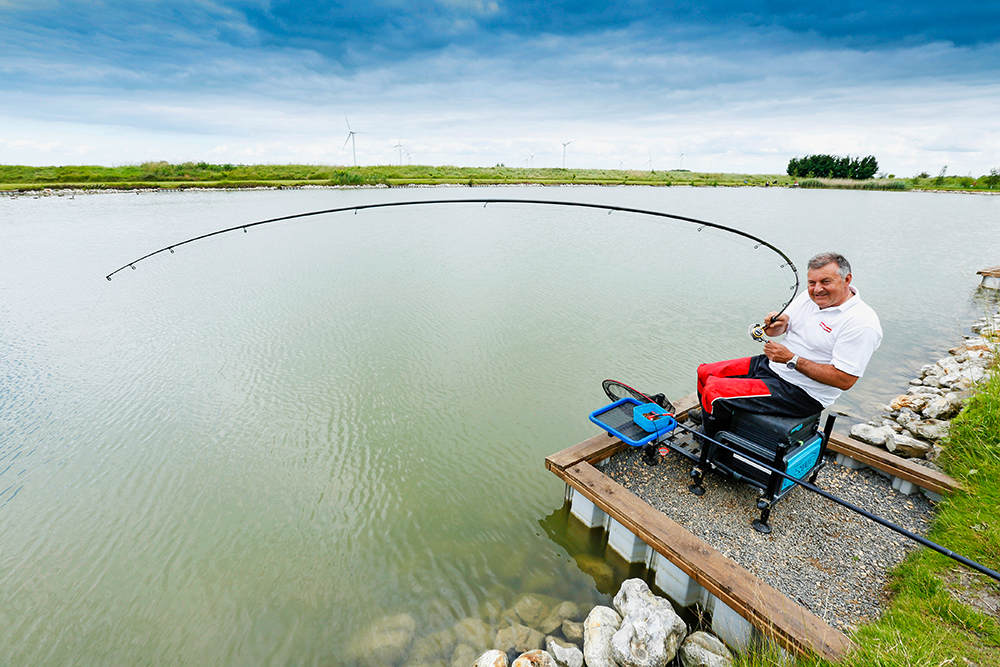
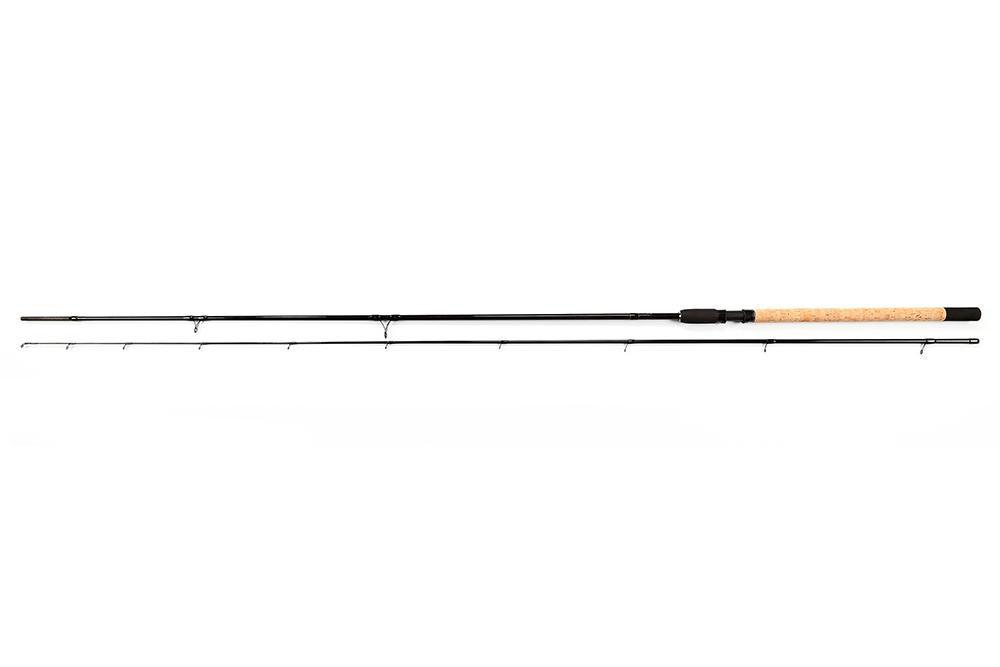
QUICK FIX
Top section: The top section of the rod has
a quick tip action with a fast recovery rate. This allows you to make longer and smoother casts.
Fittings: High-quality line guides are used throughout, producing super-slick casts no matter how great the diameter of your line.
Blanks: Made from ultra-slim high-modulus carbon blanks, they have two equal lengths so that they are ideal for carrying ready made up.
Action: The rods have a perfect parabolic non-locking action which is ideally suited to commercial fishery carp of any size.
Handle: The new Commercial King2 rods
are designed with shorter cork handles so that they can be more easily manoeuvred around the angler’s body.
PAY AROUND
£69.95
Browning has revamped its range of Commercial King rods.
The latest models retain many of the build characteristics of the originals – slim carbon blanks, two equal-length sections and a responsive, progressive action.
However, Browning has further refined its best-selling UK range with improved cosmetics, beefed-up casting prowess and a tweak to provide a little more power through the mid-sections.
All this has been accomplished without Browning significantly hiking up its prices, which something to be applauded.
So, with the summer sun in full water-warming mode and carp cruising about all over the surface of nearly every lake I have visited in the past two weeks, it made perfect sense to take a closer look at Browning’s latest Commercial King2 Pellet Waggler rods.
These 11-footers come in Medium and Power versions, the latter boasting around 15 per cent more stiffness and power for situations involving bigger fish, or casting heavier floats up to 30g.
My chosen test venue, The Pool at Fields End Fishery in Cambridgeshire, is noted for its mixed stocks, so I chose the Medium model with a maximum casting weight of 20g. This is ideally suited to lighter floats, hooks and lines.
Assembling the rod, it’s immediately apparent that this is quality kit. At only 175g, it’s nicely balanced, with a super-quick tip action and fast recovery. That means it doesn’t wobble around much, making long, smooth casts easy to achieve.
My float choice was the small flighted John Bonney model that comes free on the front of Angling Times this week. It flew across the Pool to a range of 25m with no effort. The slightly reduced handle length made feeding with a catapult equally effortless, and that made very short shrift of what can otherwise be a rather tiresome ‘feed and cast’ routine.
Feeding little more than half-a-dozen 6mm pellets every 20 seconds or so, it wasn’t long before dark shapes were coming in to feed as soon as the pellets hit the water. But, as often happens on a well-fished venue, as soon as the float splashed down, they high-tailed it out of the swim.
The answer to this fishy conundrum is to feed twice, immediately before and after casting. You will also need to feather the line, so that the float lands with a gentle kiss on the surface. Get it right, bites will be savage. You now need to get them out of the killing zone as quickly and quietly as possible, by keeping the rod low, simultaneously reeling and pulling back.
For this you need full confidence in your rod, and reel for that matter, keeping the fish moving without pulling the hook, breaking the line or having the fish charge back through the feeding shoal. Basically you are pushing your kit to it limits, and it needs to respond and perform in equal measure.
This latest Commercial King2 Medium Pellet Waggler rod does exactly that. The added bit of muscle Browning has added kicks in as the blank approaches full parabolic compression, but its non-locking action provides enough of a safety factor for you to be able to dish it out without fearing the worst.
I was also impressed with the rod’s ability to deal with fish other than carp. During the live test some pretty hefty ide decided to have a go. These are not exactly cage fighters, but can be welcome weight builders in matches.
Their lolloping ‘fall-over’ swimming action means they are effectively dragged towards the net – hook-pulls happen all too often when using carp-style pellet waggler tactics. But not with this rod. It handled everything from near-double-figure carp, through to heavyweight ide and big roach, with aristocratic disdain.
VERDICT
I really liked the original Browning Commercial King rods, rating them right up there with many of the best models then available.
These latest rods look, feel and perform with every bit as much style, but with a little more bite.
Improvements to the cosmetics and furnishings give them an expensive top-end look which belies their very sensible price tags.
Mark Sawyer
Shimano Beastmaster CX Commercial 9ft-11ft Float rod
The new Shimano Beastmaster CX rod range has been developed for small to medium-sized carp. Much modern match fishing takes place at 30 yards, so each CX Commercial blank has a parabolic fish-playing action that absorbs the power of the fight, preventing hook-pulls. There are Feeder and Float rod versions, ideal for all but the heaviest Method, straight lead and pellet waggler tactics.
PAY AROUND
£109.99
Hooray – at long last it looks like summer is on its way!
The daffs have bloomed, and on all the fisheries I have visited broods of downy ducklings swim in unison as if tied together.
As the water warms, carp are drawn inexorably towards the surface for some community sunbathing. So how can we tempt them into taking our baits?
Floating dog biscuits work, but they are banned on commercials so it’s down to pellet waggler, or wag and mag tactics.
Unless I have to cast miles, an 11ft two-piece float rod is usually my weapon of choice. Sometimes, though, especially when targeting F1s on snake lakes, casting tight up against islands or even dobbing, there’s definitely a case for an even shorter rod. Its added casting accuracy can pay dividends.
As if to second-guess me, Shimano has released a brilliant line-up of new Beastmaster CX Commercial rods, including this rather nifty 9ft/11ft model.
Not only will it cope with most commercial fishery float work, but the carbon blank includes a 27ins dolly-butt section that fits snugly into the cork and EVA handle, giving you a well-balanced 9ft rod.
In their shorter mode, dual length float rods can either be much too pokey, or limper than a Julian Clary handshake, leading to constant hook-pulls or protracted battles with fish on an under-powered blank. But after spending time with the new Beastmaster CX 9-11 I can happily report that this classy looking all-black blank offers a medium parabolic action, with an almost tippy casting performance, at both its 9ft and 11ft lengths. I’d guess that England Feeder international Rob Wootton and ex-Shimano consultant Mark Pollard had quite a bit of input into this rod’s development.
Despite its slim profile and lightweight Bio-fibre carbon build, the blank has more than enough beef to cope with the biggest of fish. It’s possibly better suited to casting floats from 4AAA upwards than it is small wagglers, and Shimano has given it a maximum casting weight of 15g, which gives it plenty of all-round scope.
VERDICT
This great new float rod from Shimano is aimed squarely at the match angler – well thought out, cleverly designed, with a build quality and furnishings normally only associated with top-end flagship models. The 9ft/11ft blank has the flexibility to be used on all types of commercials with reel lines and hooklengths of 4lb-8lb.
Mark Sawyer
Shakespeare Superteam Match 13ft rod
TECH SPEC
Length: 13ft
Power rating: 6lb
Pieces: 3
Handle: Cork/EVA
Rings: Zirconium
Extras: Side keeper ring
PAY AROUND
£89.99
You could do worse than use the Redditch tackle giant’s products down the years as a means of charting the development of the modern match fishing rod in terms of materials, furnishings and specifications.
A potted history of Shakespeare notables would show the fibreglass Match International as a rod ahead of its time. This was followed by the excellent, if rather expensive, President which I believe was the first carbon fibre rod to be built with a spliced-in tip.
Then we had the superb Mach 2 Boron which held centre stage with matchmen for many seasons, but was eventually superceded by the Mach 3 carbon. Since then we have been blessed with the firm’s high-modulus carbon Superteam model, launched in 2014.
Shakespeare did, of course, introduce many other match rods but those listed above were widely recognised as being as good as it got back in the day. Remember, it wasn’t all that long ago that match fishing was all about using a waggler or stick float to catch winning nets of roach, chub, dace, perch or bream, the tool of choice being a 13ft, three-piece.
The finesse to deftly flick a small waggler across a canal, cleanly pick up line from the surface when long trotting and cast bodied wagglers or sliders into deeper water on rivers and lakes, are qualities we expect of any good match rod.
That brings me nicely on to Shakespeare’s Superteam 13ft match rod which really is a jack of all trades and will take all these tasks in its stride. Yes, this rod was first introduced a few years back, but that doesn’t make it in the least bit tired or dated. It remains to this day one of the best all-round match-style float rods that few others can hold a candle to.
The three-piece pencil slim carbon blank is nice and light in the hand, making it easy to hold for long spells, and a requirement of any good river rod. Worthy of note are its zirconium oxide guides that enable almost friction-free line travel, very useful when trotting a river at the pace of its current.
Its fast, progressive action doesn’t lock up under stress, so when you hook into a really big fish the blank will absorb and keep absorbing its runs and lunges with no fear of the line snapping. At the same time it has the backbone to boss fish away from snags.
Live testing the rod was interesting, as I already had some idea about the Superteam’s performance from an earlier Angling Times review. This time, rather than take it to a carp puddle or river, I thought I would test the blank’s sharpness and line pick-up qualities on a deep venue I knew held some big roach and decent ide.
Waggler tackle with small hooks and maggots, coupled with a nagging easterly side wind, wasn’t perhaps the ideal mix for a decent day’s fishing. But I needn’t have worried – Shakespeare’s finest 13ft of carbon cast a hefty three-swan insert waggler with ease and unerring accuracy.
With the float set at 12ft deep, line pick-up speed was central to hitting bites and the rod didn’t disappoint, connecting time and time again with the most tentative of enquiries.
As the fish responded to the feed they started coming up in the water, and bites became lightning-fast.
Now the line needed to be whipped from the surface at a rate of knots, and yet again the rod performed impeccably. Not merely a jack of all trades but a master of them all.
VERDICT
Another pure class floatfishing rod from the Shakespeare stable and perfect for silverfish, the Superteam 13ft is tactically flexible and ultra-reliable. Use it with confidence, however light the terminal tackle. Its anti-locking nature and progressive action allows it to cope with sizeable fish, something that cannot be said of many old-school float rods.
Middy Baggin’ Machine Synaptic Duo rod
TECH SPEC
Two tops: Waggler and Feeder
Features: F-Lined Guides, hook retainer, two spare quivertips, Synaptic carbon design, ergonomic reel seat.
Casting weights: 2g to 25g Wagglers; 10g to 45g Feeders.
PAY AROUND
£109.99
This Middy Baggin’ Machine Synaptic float and feeder Duo is ideal for anglers on a budget who want a single rod to cover a multitude of different methods.
It has two separate top sections and comes with two push-in quivertips to make up a 10ft feeder rod that’s perfect for parrot cage commercial fishery pegs. With the feeder top, the rod is capable of fishing Method feeders up to 45g as well as cage and blockend feeders and straight leads. It has a soft progressive fish playing action, but with loads of power down the blank, and will handle reel lines up to 10lb with hooklinks up to 6lb. There’s also plenty of power to land double-figure carp, and the rod feels nicely balanced and responsive.
During a live test at the impressively stocked Lou’s Lake at Cambridgeshire’s Decoy Lakes, the rods mettle was well tested with plenty of F1s, as well as the odd larger carp. It cast a fully loaded Method feeder with impressive accuracy up to 30m with ease. The Synaptic blank is made from carbon and glass, which produces a very lightweight, fun-to-use tool, with an almost anti-locking action. Hook pulls are kept to the absolute minimum.
With the waggler top fitted, the rod is still 10ft in length, and will cast floats between 2g and 25g, making it ideal for up-in-the-water pellet waggler tactics. It can handle reellines up to 8lb and hooklinks up to 5lb.
The waggler section has a little more stiffness through its mid-section than the feeder top, but it still retains plenty of cushioning forgiveness, and is more than capable of absorbing last-minute lunges from even the largest of fish at the net, without risking hook pulls.
VERDICT
The Middy Synaptic Duo would make the perfect tool for the summer pleasure angler. Designed for use mainly on commercial carp fisheries, the rod is easy to transport and equally at home fishing a Method feeder or a pellet waggler.
Drennan Acolyte Feeder Plus 12ft rod
PAY AROUND
£189
Tackle giant Drennan has recently added two new models to its top-end Acolyte Feeder series. The latest 10ft and 12ft Plus rods are said to be the most powerful within the family, which includes 10ft, 11ft and 12ft Ultras with lighter actions, as well as an existing 11ft Plus rod.
The 12ft Plus model I tested is constructed using the same super-slim, two-section high modulus carbon blank featured on all Acolyte Feeders. But on this rod its mid to top section areas have been substantially beefed-up, to provide the blank with a higher weight loading point.
This not only aids its casting potential, enabling feeders and leads to be propelled greater distances, it also allows heavier weights up to 60g (2oz) to be used.
Drennan claims casts up to 60m are easily achievable, with even greater distances possible if you have good technique and, having live-tested the model on a large open water venue, I wouldn’t argue.
Other notable features are its stand-off SiC lined guides that help to keep the line well away from the blank, enabling the reel line to move quickly and smoothly through its guides, again to help distance. To that you can add a high-quality original Fuji screw down reel seat, full length 23ins-plus cork handle, and three push-in carbon quivertips, which have been selected to blend in with the rod’s parabolic fish-playing action.
So when, where and how would you use this rod? It’s certainly well suited for large expanses of open water – including rivers – and for all species of big fish.
The blank’s extra backbone provides plenty of casting clout which makes it ideal for all types of feeder and straight-lead tactics, just as I experienced at Lincolnshire’s big-fish mecca Bain Valley at Tattershall Thorpe.
The fishery’s windswept and open Halifax Lake holds some very big carp, which are noted for their fighting qualities. During the warmer months when the water is coloured, these can be caught on a pole in the margins, but once the colour starts to fade away, so do the fish. And like so many big waters in clear conditions, fish tend to shoal up towards the middle of the lake, a good 70m from the bank, more than a decent cast for any type of feeder rod, let alone one with such a slim profile as the Acolyte Plus.
Bread is the key bait, as it is on so many carp lakes in the cold. But Bain Valley is deep, so the punched disks need popping-up some three feet off the bottom to find the fish.
The longer hooklength adds yet another degree of difficulty to the cast. However, a decent sized bomb soon sorted this problem out. I did feel, though, that using an ounce-and-a-half of lead at around 65m-plus, the blank was on the upper limit of its capacities. To be fair, it was a very long chuck, and the Acolyte’s tip recovery post-cast, and its responsiveness, were never found to be wanting.
The rod’s push-in quivertips are faultlessly matched to its carrier section, with the 2.5oz, 3oz, and 4oz carbon quivers ideally suited for Method feeders and all hair-rig tactics.
Once a fish is hooked the blank’s action is surprisingly robust, and enables you to pull very hard without it ever feeling as though it might fold when under pressure – perfect for all big fish, not just carp.
The 12ft length enables a quick contact to be made with fish hooked at distance, and nothing that I caught while live testing, ever felt like it could dominate proceedings, which again for such a light and slim rod is very impressive.
I wouldn’t use it with small hooks and light lines, as I feel it had a little too much stiffness toward the end of the carrier section for gossamer gear, but as it wasn’t designed for that anyway, it’s hardly a criticism. I am, though, surprised that Drennan hadn’t moved the butt guide further down the blank, even if it meant losing a guide further up (think carp rod) as this may have added even more casting prowess.
VERDICT
Another sure-fire winner from Drennan. The Acolyte Plus feeder would be every bit at home on Boddington Reservoir as on the banks of the Severn or Trent. Thanks to its same-length design, and top ‘n’ tail retaining bands it is easily transported ready made-up, and is sure to be popular with long-range feeder fishing fans.
Mark Sawyer
Preston Innovations Competition Pro 12ft Medium Feeder rod
PAY AROUND
Preston innovations Competition Pro 12ft Medium Feeder
RRP: £109.99 (but shop around)
PXR Pro 4000 reel
RRP: £104.99 (but shop around)
Not quite as cheap as chips, but more versatile than a Swiss army penknife, is this tasty pair from the Preston stable.
The three-piece 12ft Competition Pro feeder is as much at home dishing it out on rivers as it is battering them down at your local commercial carp venue. The all-carbon blank is nicely put together, and features an old-school full-length 25in cork handle with screw-down reel seat and EVA thumb grip.
Its seamless, flat spot-free progressive action is ideal when targeting big bream, carp, barbel, tench and, of course, chub. The lightweight blank has just about enough softness at its tip to make reel lines of 4lb-8lb with hooklengths down to 0.12mm diameter feasible and, like all good feeder rods, this one has a very high loading point.
This means that when a feeder is attached, the rod only bends from its tip, enabling its backbone to kick in and propel the feeder forward, rather than just lobbing it up and out, as happens when the weight loading area is too far towards the mid-section.
Other features on this Preston rod, which the manufacturers suggest will cast feeders up to 60 metres, are eight low-profile large diameter lined guides. The six equivalent guides on the two spare quivertips also have enlarged diameters, so if you’re off to Ireland, where heavy shockleaders are often used to cushion long casts and protect against zebra mussels, you shouldn’t suffer the annoyance of having the knots catching in the eyes.
The perfect foil for this rod would be its matching Preston branded reel, the award-winning 4000-sized PXR Pro. This model is ideal for winching in heavy feeders and is packed with features including a lightweight aluminium body, quick-release push button spool (plus one spare), precision front drag system, robust stainless steel hollow bail-arm and hard chrome-plated line roller.
Most importantly it runs smoothly and tirelessly on six stainless steel bearings and generates a 4.9:1 gear ratio.
Live testing tackle in winter can be tricky. With the bigger rivers out of sorts, but fed up with bagging commercial carp, where else could I take the Preston pair to prove their mettle? The light-bulb moment eventually came and we were off to Northamptonshire’s River Ise. A stealthy approach using a small cage feeder packed with liquidised bread, and flake on the hook, would hopefully prove successful. The set-up was simple. The reel was loaded with 5lb mainline straight through to a running feeder, stopped with No.8 shot 12in from a size 10 hook. First cast saw the tip tremble, and then it trembled again before pulling round in a classic chub bite. A spirited fight saw a fair sized fish lunging for the nearside reeds, but the 12ft Competition Pro Feeder had a bit too much backbone for any of that old malarkey, and quickly thwarted my quarry’s escape plans.
Through pouring rain, covered in mud, bread and fish slime, both the Preston items performed faultlessly and they get a huge thumbs-up from me.
VERDICT
If there were such a thing as a ‘one-rod does it all’ feeder model, Preston’s Competition Pro Medium Feeder would comfortable pass the test. Every bit as much at home on a commercial carp fishery as it would be bream-bashing on an Irish lough or fishing a big river for barbel, it’s a great all-rounder. As for Preston’s PXR Pro reel, you don’t have to spend long using one to see why the angling public voted it the best reel in its class last year.
Daiwa Harrier Match 13ft rod
PAY AROUND
£54.99
There was a time not so long ago when a three-piece 13ft float rod was standard issue for all match anglers.
Sheffield, Leeds, Rotherham and Birmingham all boasted legions of matchmen whose angling clubs were linked to massive national industries and working men’s clubs. Every weekend would see charabanc outings to the banks of the Witham, Welland, Trent or Severn, where floatfishing was still king and legering came a very poor second.
The best float rods of the day were mainly built on a Golden Jubilee blank, reappearing as WB Clarke’s
All-England, Milbro Enterprise or Billy Lane Match rods.
The first carbon rods weren’t far away, though, and when Fothergill and Harvey’s carbon blank appeared in 1975 they cost a king’s ransom at £133. The early carbon rods, nowhere as good as today’s, cost the equivalent of over £3,000, as much as you’ll pay for a modern flagship pole.
This history lesson earns a place here because 13ft float rods, once the most popular on the market, have evolved tremendously and are available at a steal of a price.
One such model is Daiwa’s 13ft three-piece Harrier Match, which can be found for as little as £44.99.
The rod is built on a decent enough lightweight blank, making it easy and comfy to hold. Its medium-fast action will cast small 3AAA wagglers with no trouble, and it boasts a full cork handle with an EVA lock-down foregrip, lined guides and a matt low-glare finish.
It isn’t the crispest float rod I have ever come across, and it may lack a bit of finesse. But what it can do in spades is handle whatever comes its way – something I was to find out while I was live testing the rod at Boston’s Westwood Lakes.
I had set my stall out for a net of roach and ide, or maybe the odd bream, but the tea-stained Kestrel Lake looked that dirty, I’d have been content to get a bite from anything.
With Storm Imogen racing with unstoppable force across Lincolnshire, this was far from being the best of conditions for floatfishing.
Still, with a 0.10mm hooklength and size 20 red maggot-baited hook on a slow-falling rig, something would surely have a go… wouldn’t it?
It seemed like an age for the bite to come, but eventually it did, and the blaze-coloured float tip sank slowly beneath the surface.
The strike was met by a little more resistance than I had expected, and the rod instantly took on an alarming fighting curve. This action, best described as on the through side of progressive, is pretty much what you want from a float rod if you’re likely to encounter bigger fish.
At first I thought I’d hooked, or even foul-hooked, a carp, hardly what I wanted from a silverfish session, and especially since I was using such lightweight terminal gear.
But as the scrap progressed it became obvious that I had hooked into one of the lake’s legendary barbel.
My balanced tackle was never more welcome than when I slipped the net under a pristine winter Bertram!
The Harrier Match, a long way from being one of Daiwa’s most expensive rods, had absorbed every lunge without my ever breaking sweat that I might get busted up and lose the fish.
Yes, it can be used for small silverfish, but take it from me, the Harrier is capable of an awful lot more when called to battle stations – just like its aircraft namesake, in fact.
VERDICT
On a day when everything but the roach wanted to feed, the Daiwa Harrier proved itself as a great silverfish all-rounder, with enough backbone to cope with much larger quarry when the need arose.
The rod would be well suited to a mixed commercial fishery, where the next bite could come from a matchbox-sized rudd, a powerful carp or, best of all, a belting barbel.
Mark Sawyer
Browning Sphere 10ft Bomb rod
TECH SPEC
Length: 3m (9ft 10ins)
Sections: 2
Max recommended casting weight: 50g
Spare quivertips: 0.5oz, 0.75oz, 1oz, 1.5oz.
Weight: 133g
PAY AROUND
£249.95
Those who regularly read my tackle review pages will be aware that I have been raving about Browning's top-of-the-range Sphere Feeder rods since first clapping eyes on them a year ago.
I adored them at first sight, and was bowled over by their lively, springy and steely feel and seamless non-locking parabolic curves. Live-testing them has proved to be nothing short of stupendous. They have casting power to burn, with recoil-less rigidity matched with a high weight loading area that will propel a feeder or lead a very long distance, even in the hands of a 'standard' distance casting angler like myself.
But - and here's the best bit - somehow the technical boffins at Browning have been able to produce blanks which blend all of that sizzle-factor with an almost imperceptible finesse which only comes into play when you hook a fish. Clever eh?
Faults are hard to find, other than the weight of their price tags, but they are right up there among the best.
Plaudits aside, there was one model left in the Sphere range that I had been waiting patiently to live-test, until the leaves started falling from the trees.
In the comfort of Browning's showroom, this rod felt ideal as a cold-water commercial-fishery tool, ideal for targeting F1s using light lines and small hooks, as well as being able to cope with the odd bigger fish. So as I tackled up on Decoy's unit-packed Beastie Lake, I was hoping for a live test encounter which would live up to my ambitious expectations.
I wasn't disappointed. The first thing you notice is that the blank has a long butt section at 5ft 2ins and a short a (3ft 4ins) carrier section, although when one of its four 23ins glass quivertips are fitted the two sections become equal length, making it easy to carry around as a ready-made.
Browning rates the rod as optimised at around 30m casting distance, which for me was under-gunning its true potential somewhat. My chosen peg was opposite an island end with a paddle type aerator as an added feature. My guess would have been it was around at least a 50m chuck, well above the rod¹s rating, and made even more difficult by the somewhat less than streamlined shape of the 20g pellet feeder I had tied on.
Not a problem! I even had to feather the line a little to avoid an overcast, and once clipped the rod hit the distance every time without fail. All very impressive, but not as impressive as what went on over the course of the next few hours. It¹s called Beastie Lake for a very good reason. Barbel, carp and F1s all grow fat healthy in this fabulous lake, and the Sphere handled them all with consummate ease, even when I had a dabble down the margin.
The resident barbel know every root-end and snag, but the rod pulled them away quickly and cleanly without a creak of complaint. I purposely over-loaded the stress-factor by pulling directly from above in an attempt to make the blank rotate, which in turn makes the guides twist out of alignment but they stayed die-straight throughout the ordeal.
I went through the card with this rod - maggot feeders with small hooks and 0.10mm hooklengths, pellet feeders with heavier lines and hair-rigs, straight lead and pellets - it was faultless. It would happily cope with main lines or braids from 4lb to 8lb and will cast up to 30g weights easily enough. Plus, you can use it with light lines and small hooks as its soft action is very forgiving, so hook pulls are kept to a minimum.
The four push-in glass quivertips are rated 0.5oz, 0.75oz, 1oz and 1.5oz which helps to provide it with sensitivity and durability.
Although it carries a bomb rod tag, the Browning Sphere model shouldn¹t be thought of as an old-school whispish wand designed for winkling out silvers from flooded rivers or canals. It¹s a very modern model with the casting backbone and parabolic fish playing action required for nearly all standard commercial fishery feeder and lead work.
The pencil slim blank has a superb transmission and steely feel, perfectly matched with the forgiving softness that is a hallmark of the Sphere range. If you¹re into the commercial fishery scene then you owe it to yourself to have a closer look.

